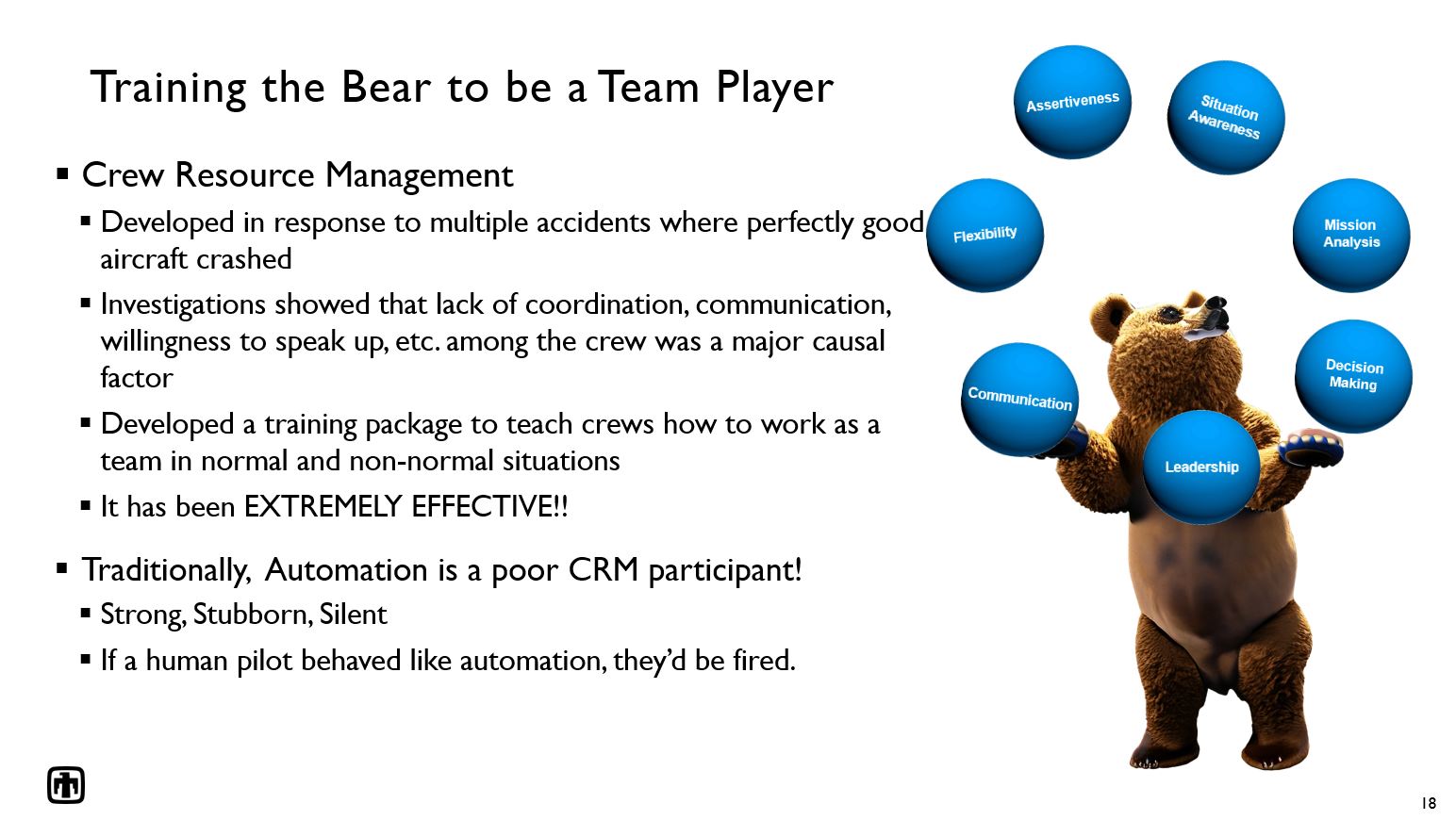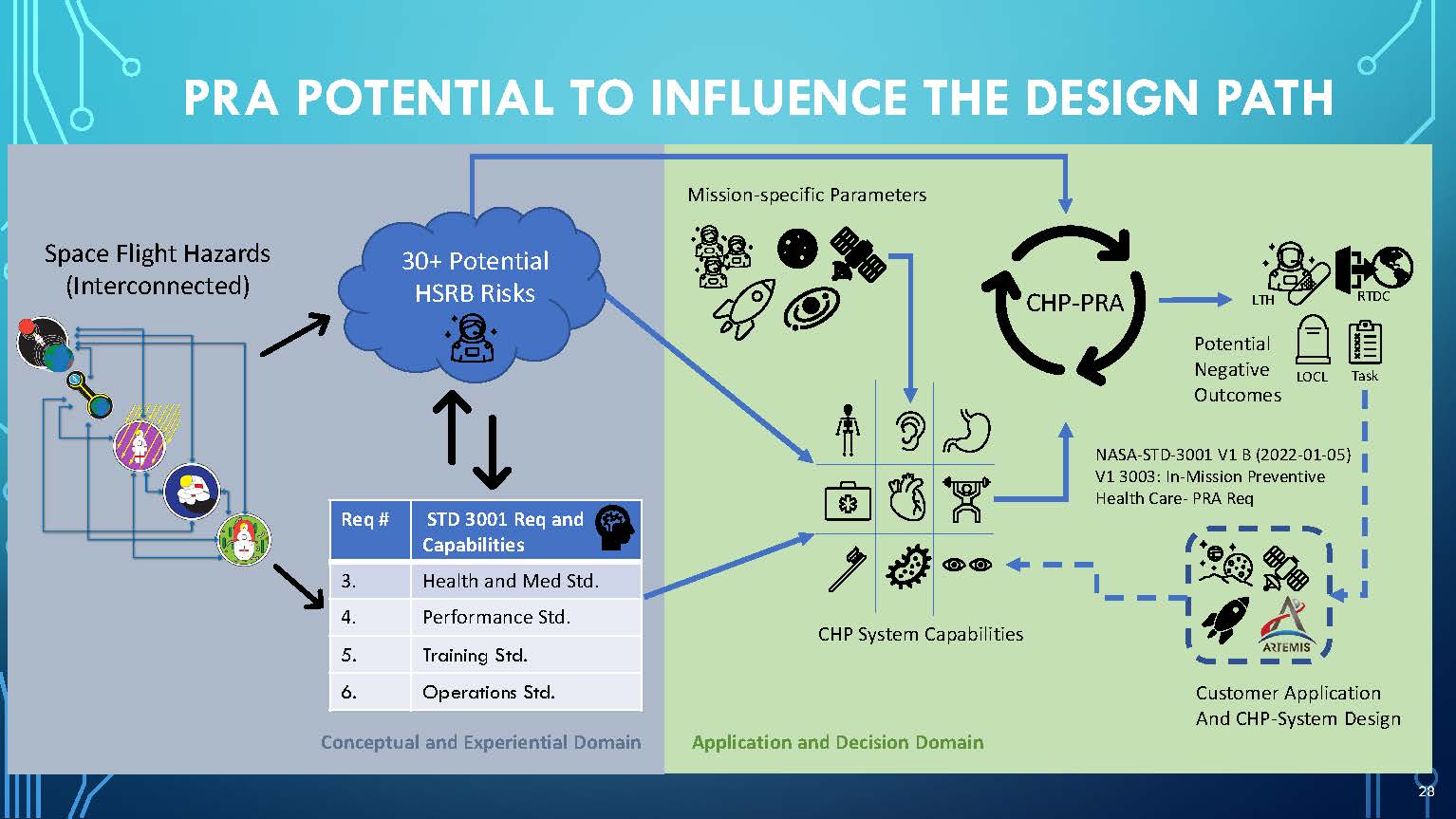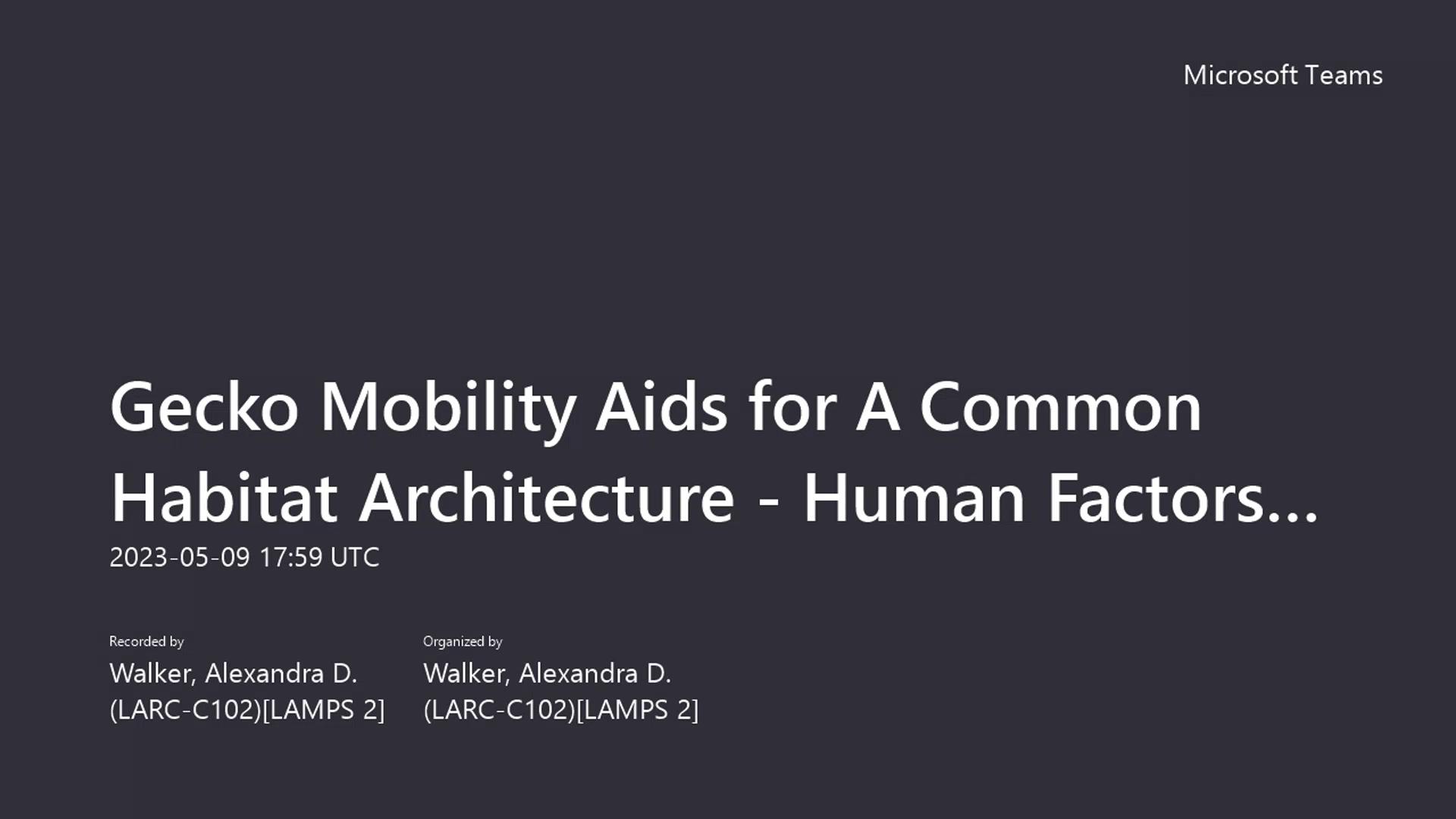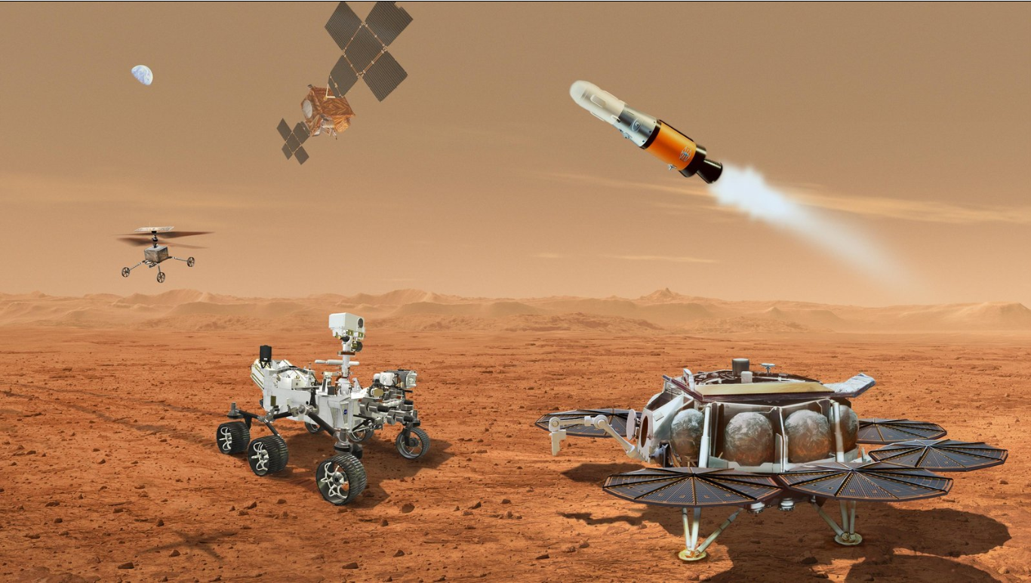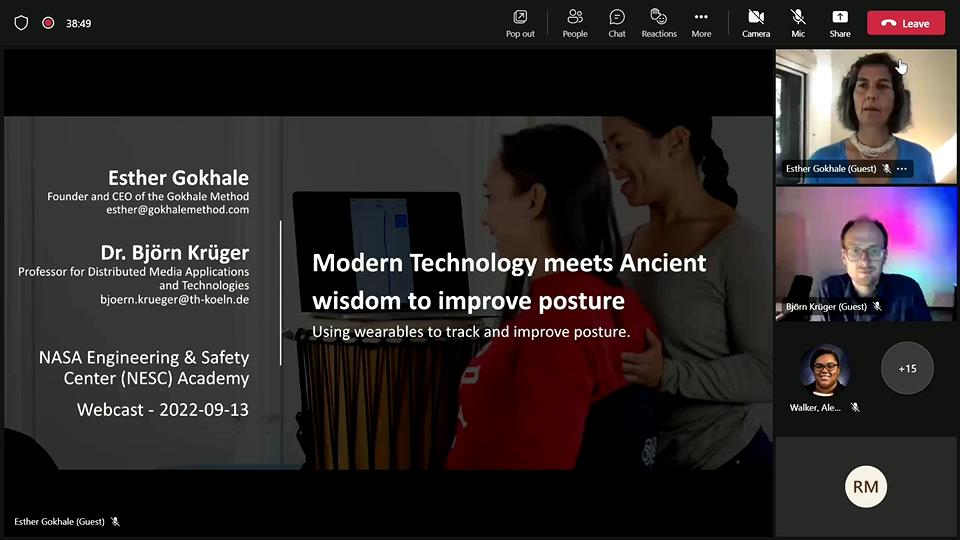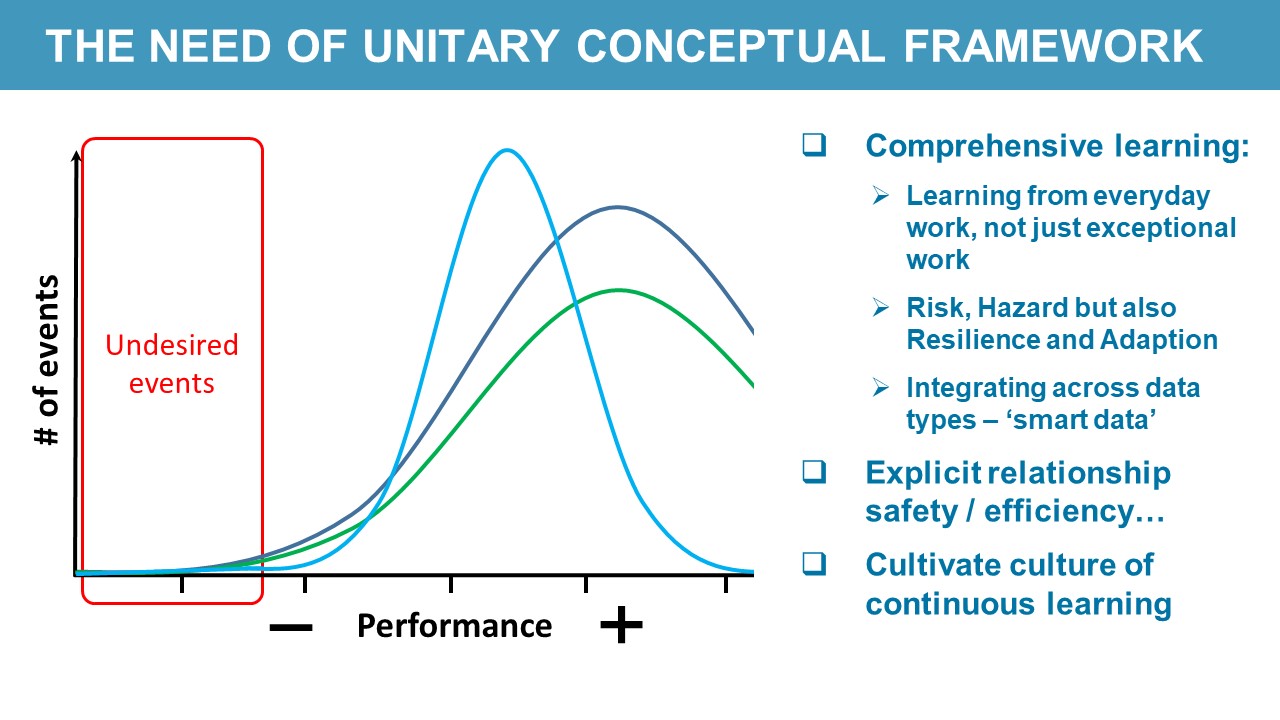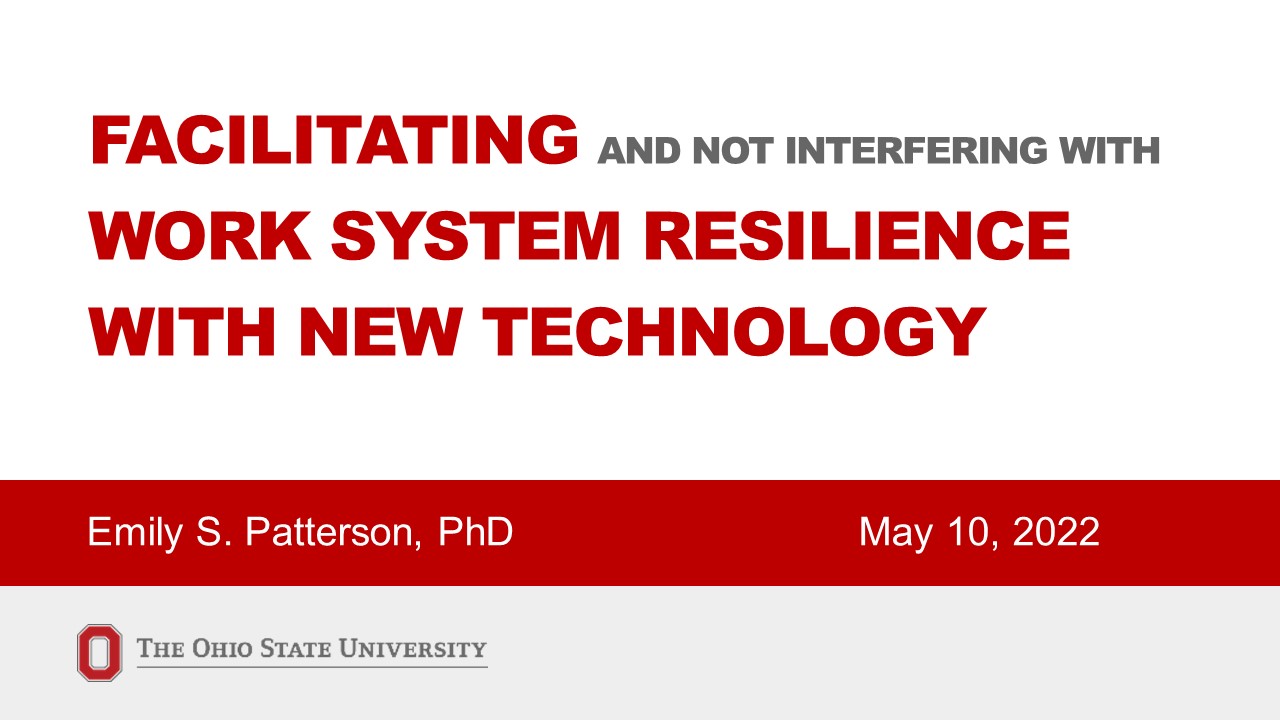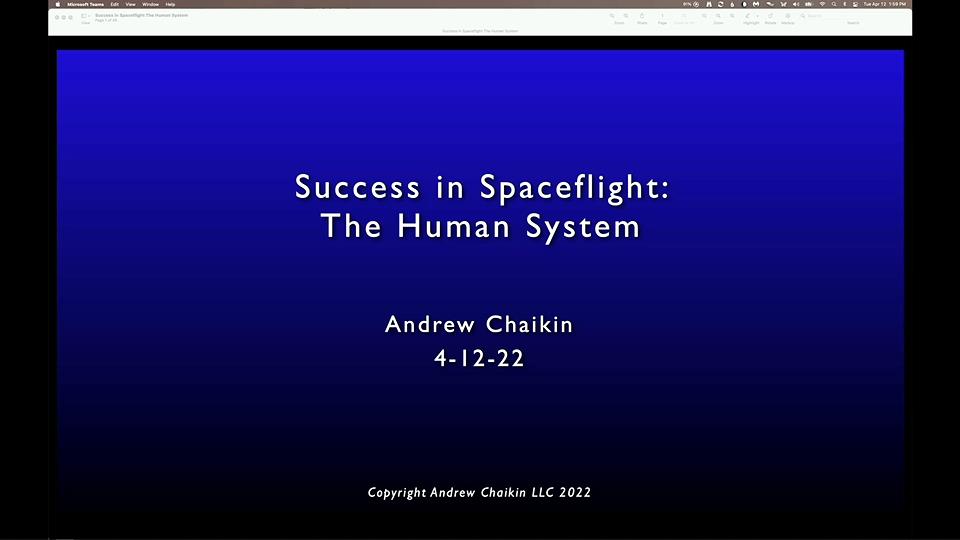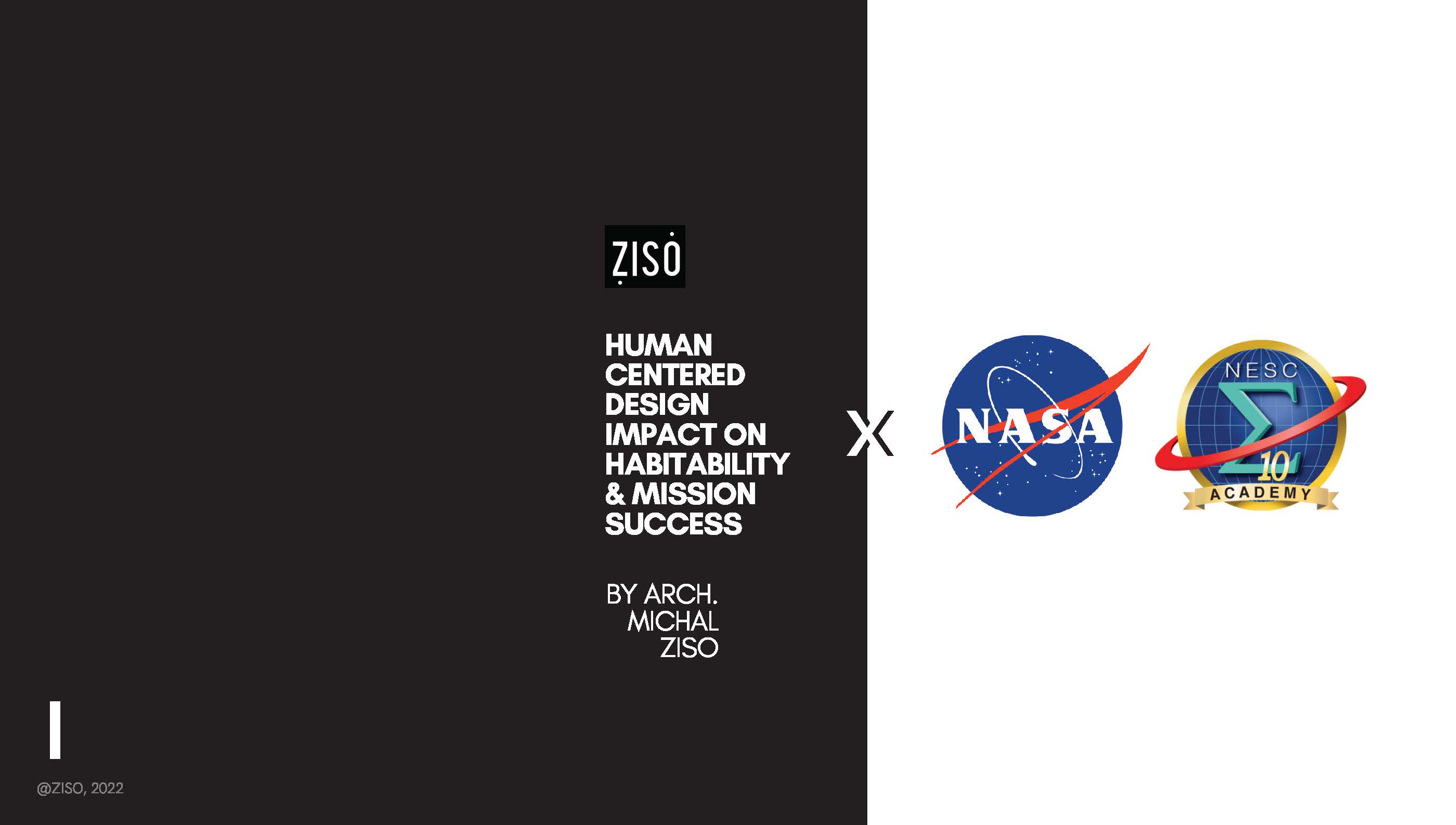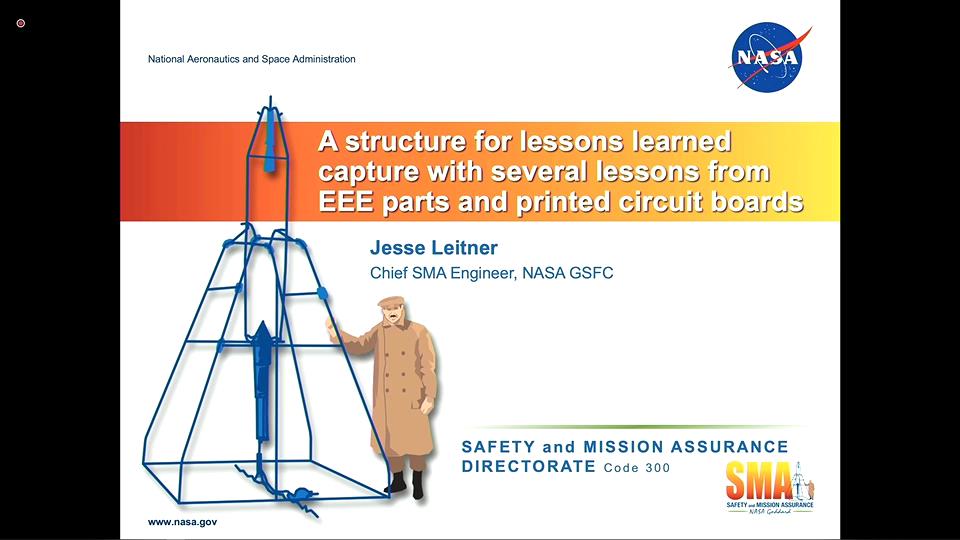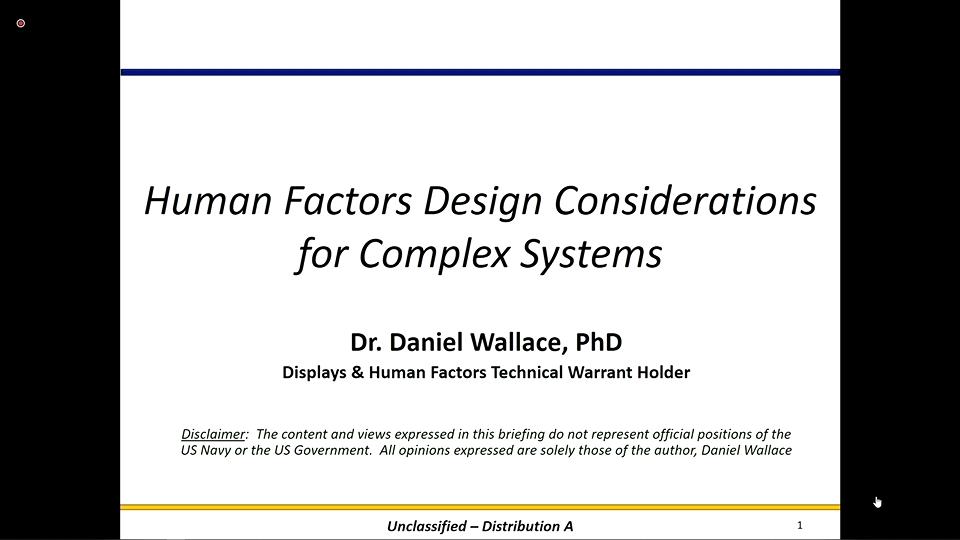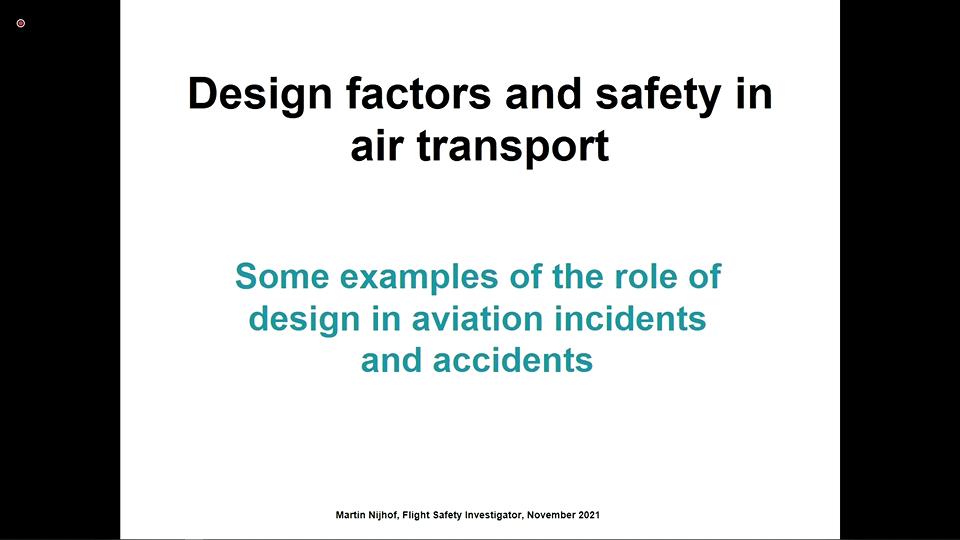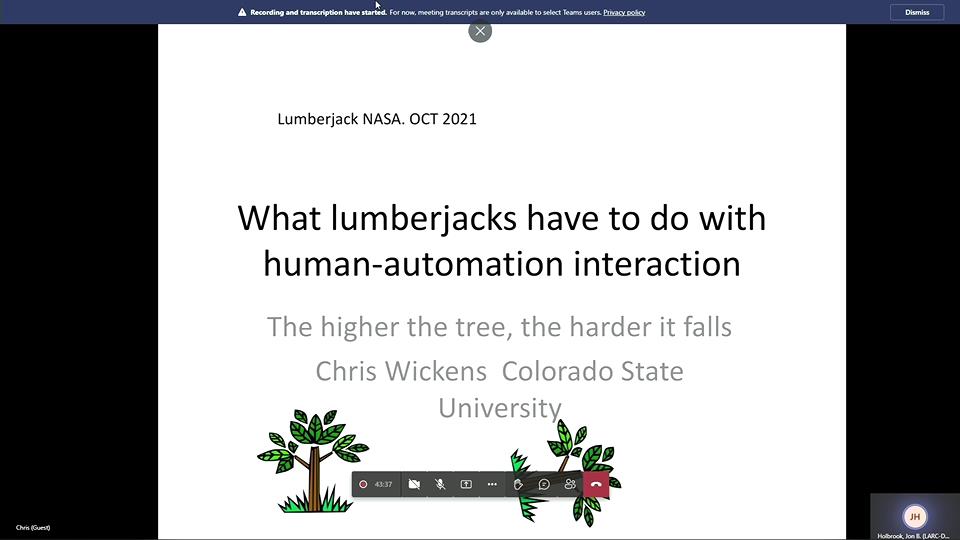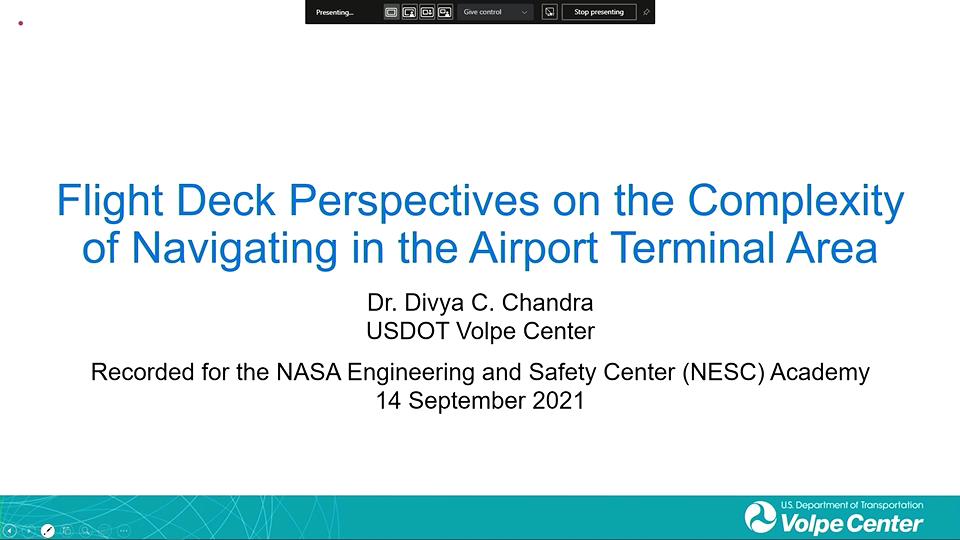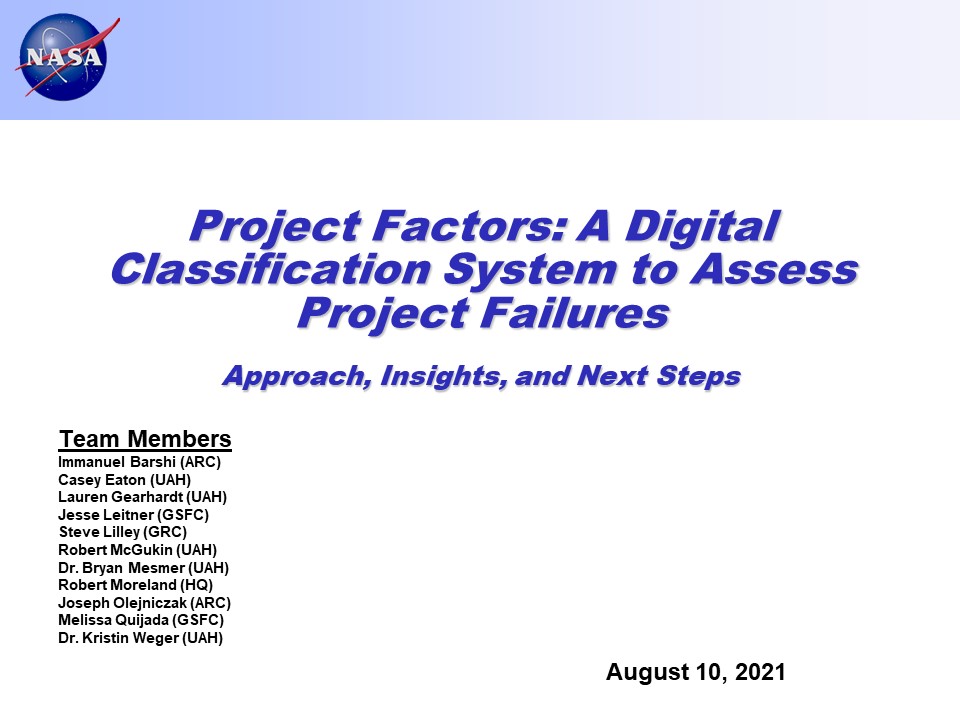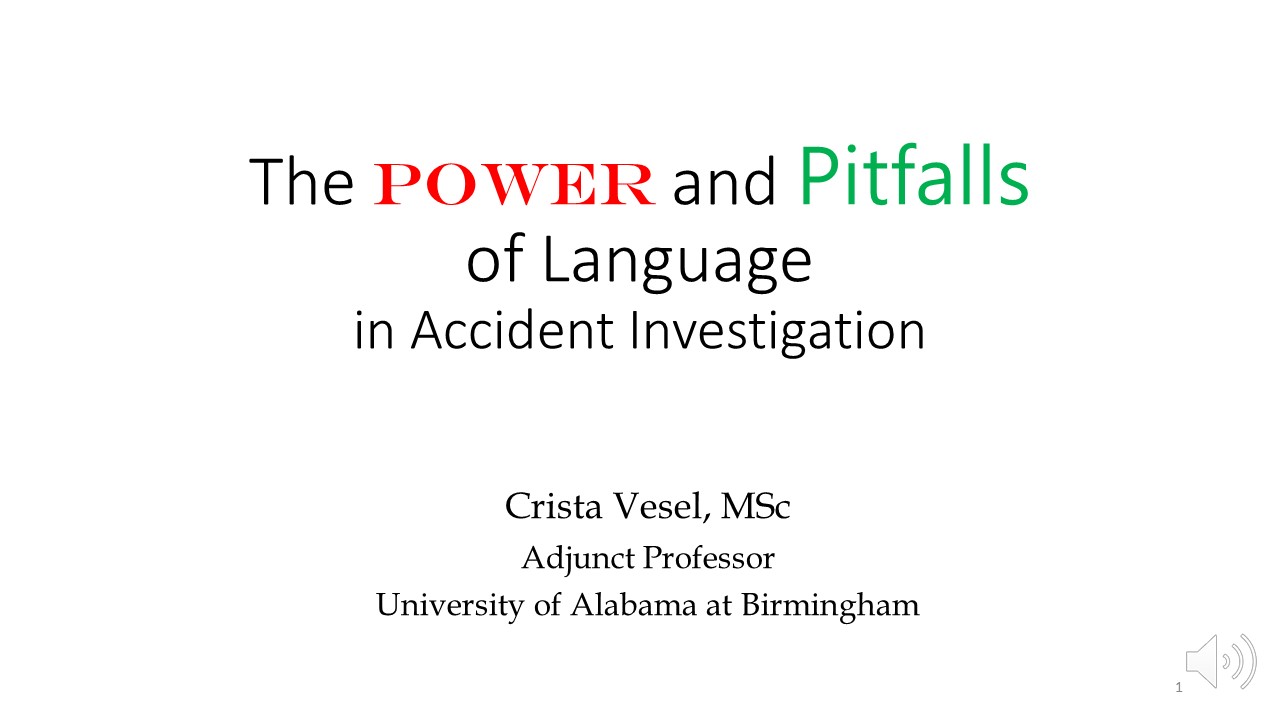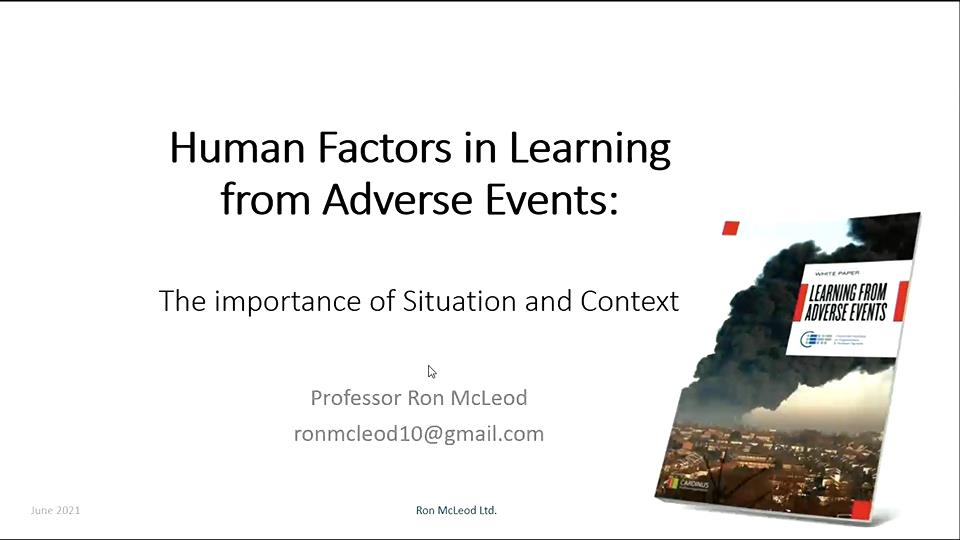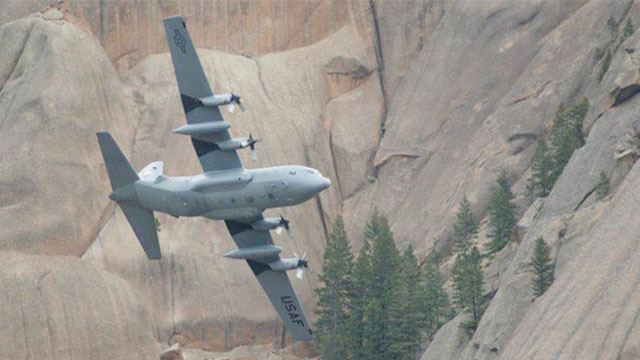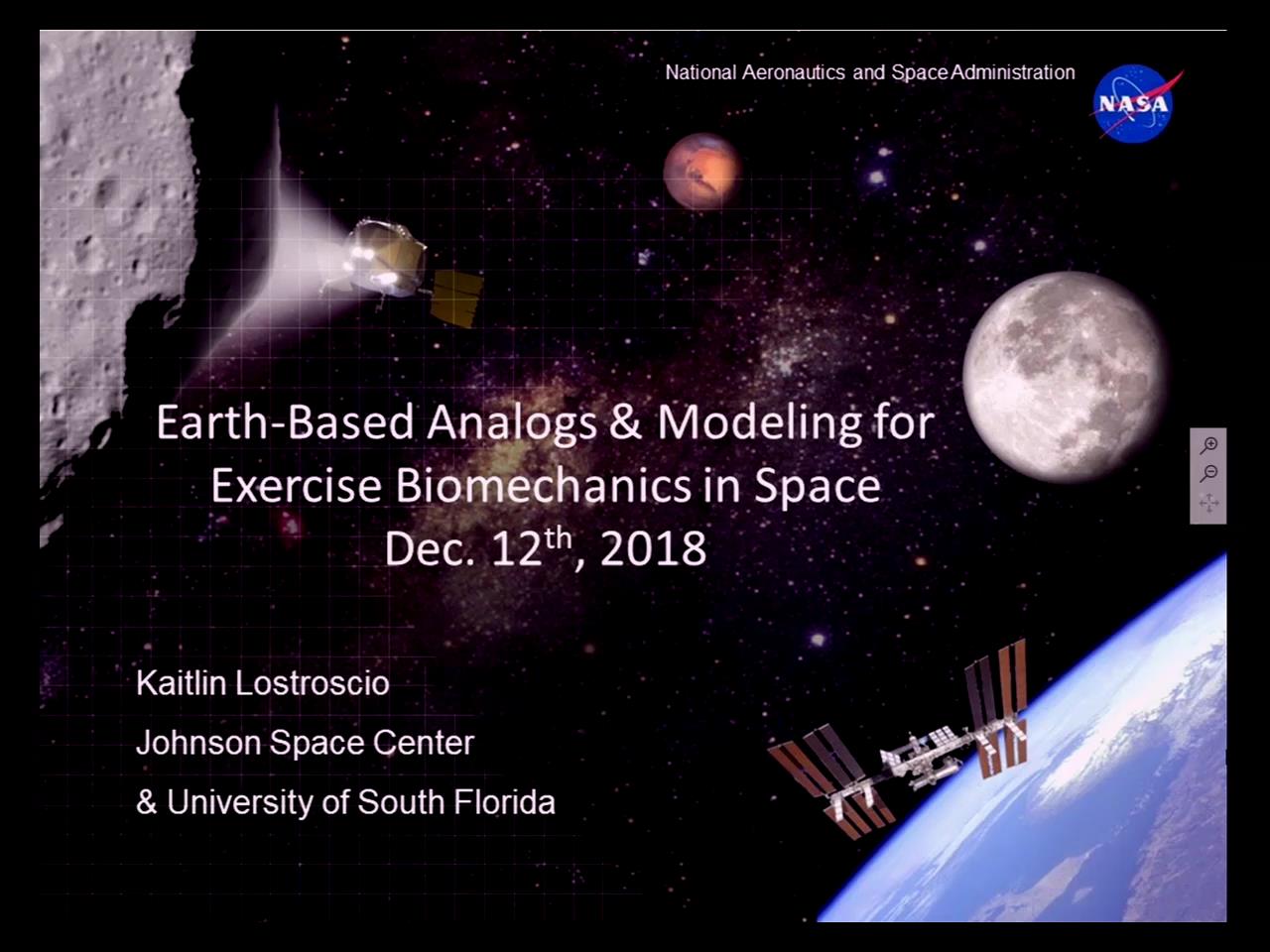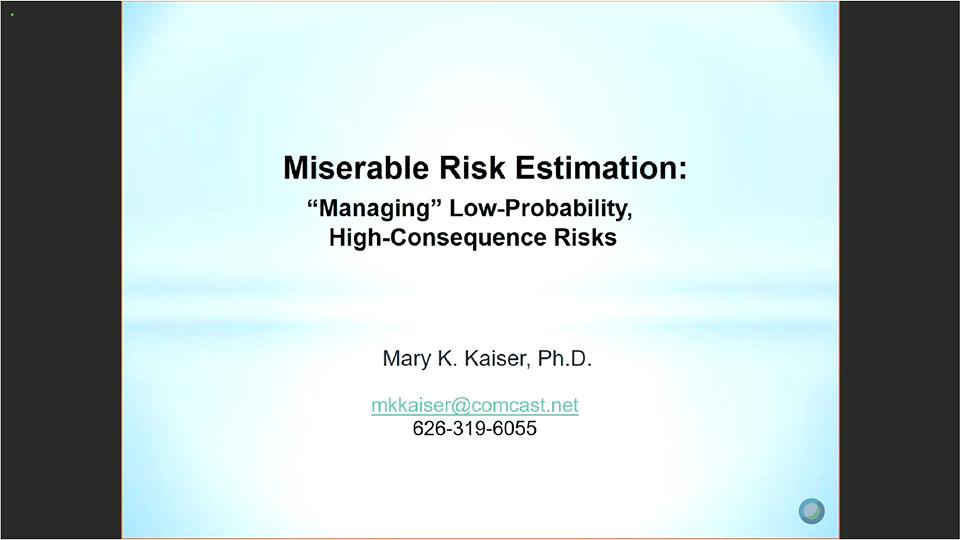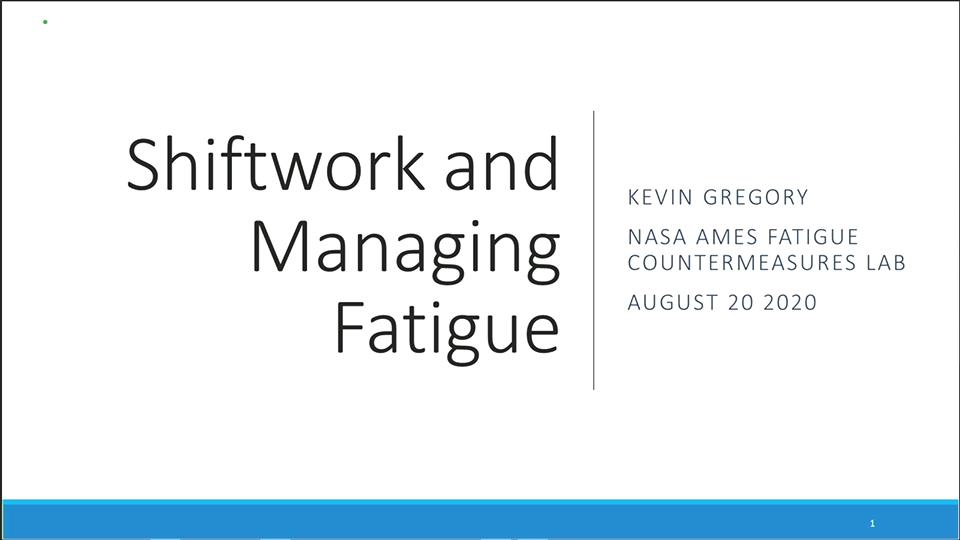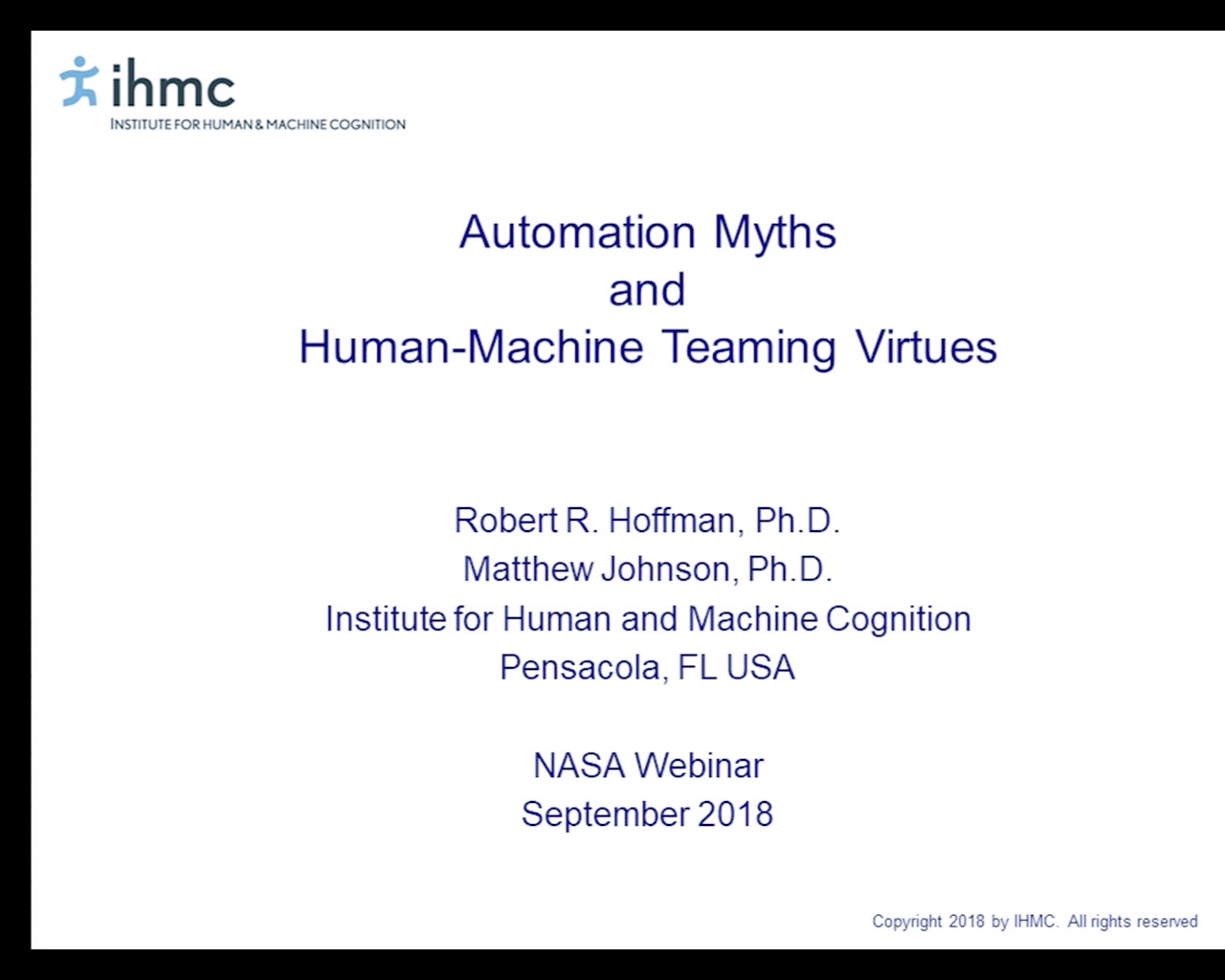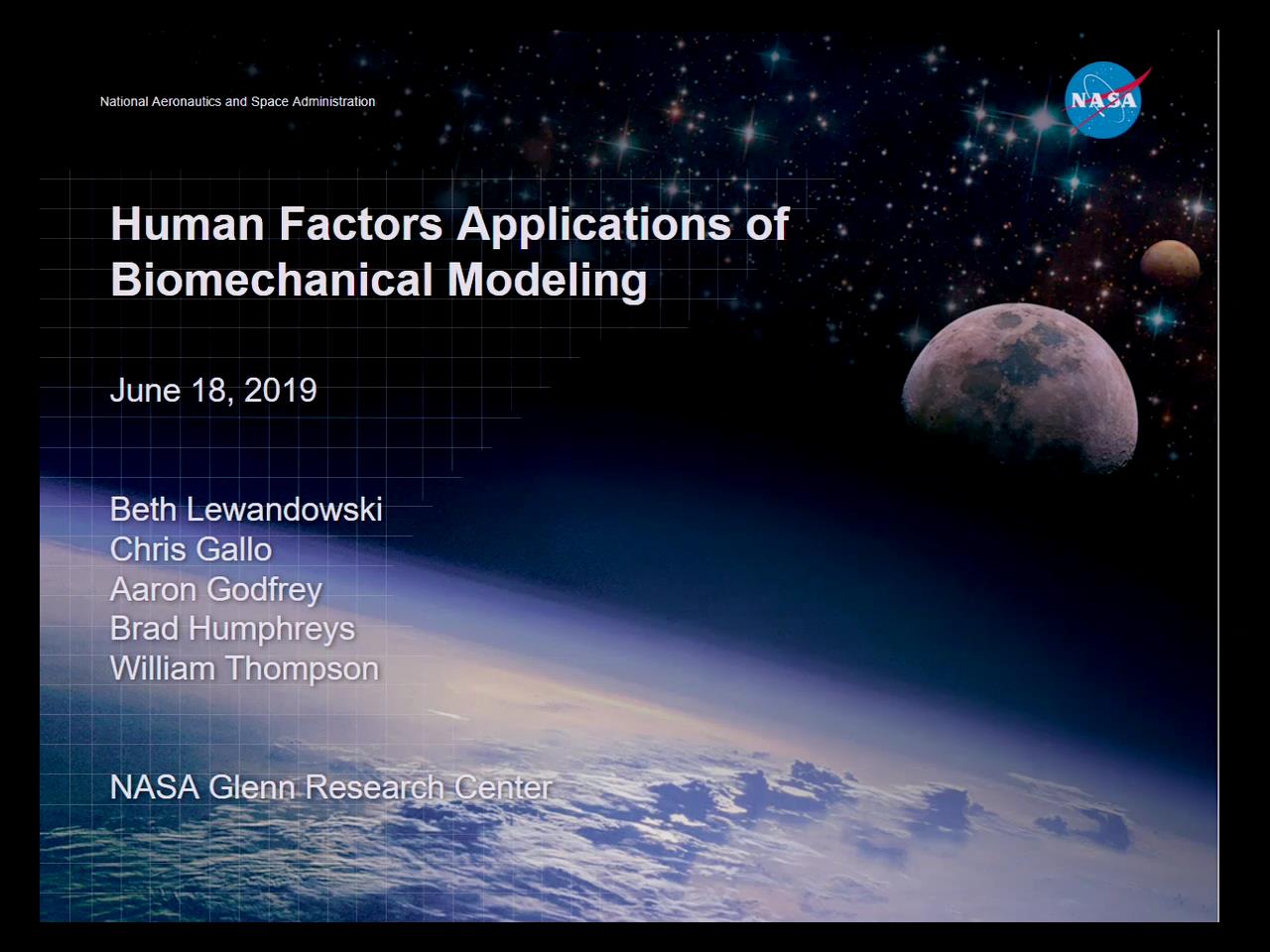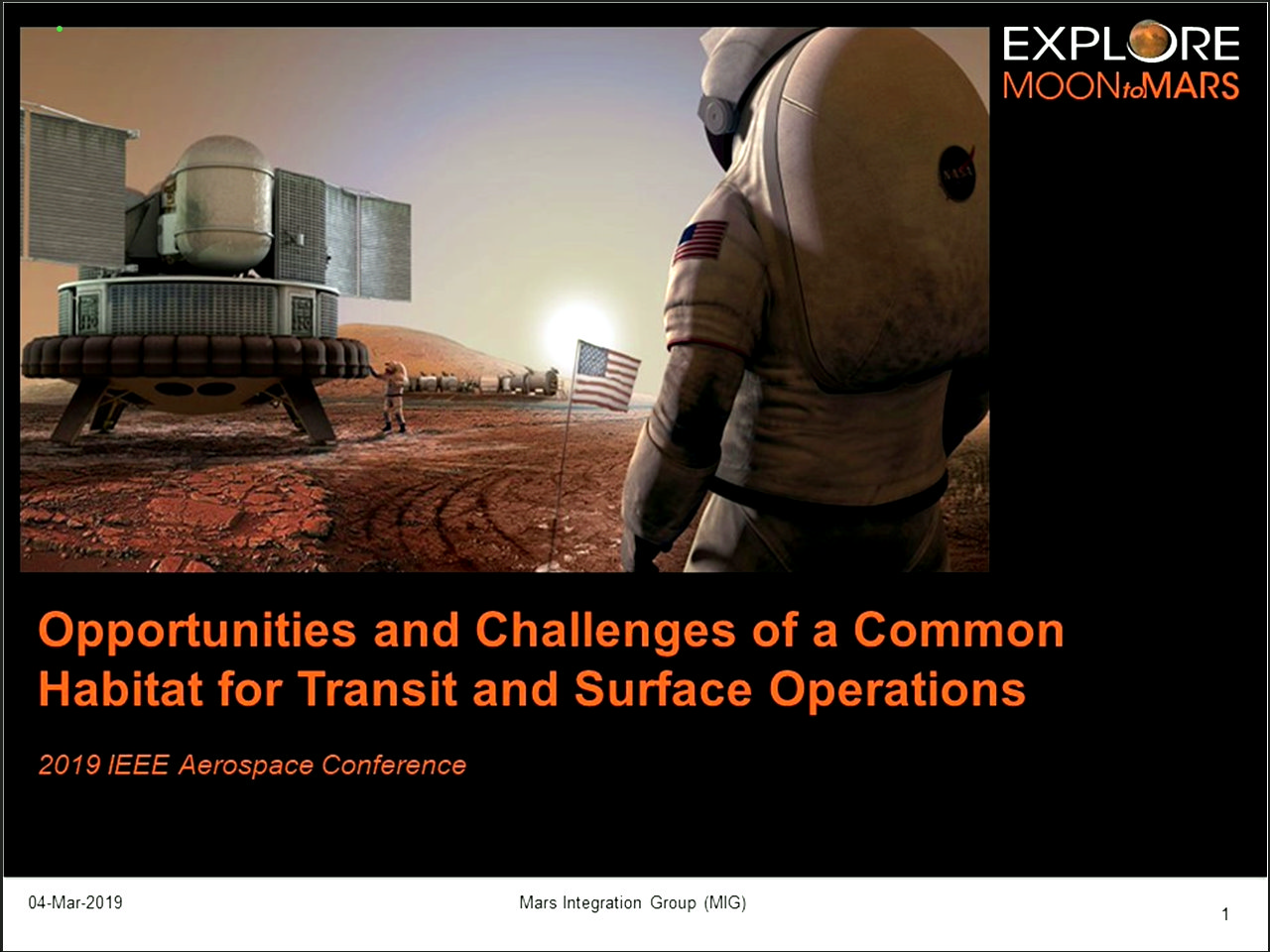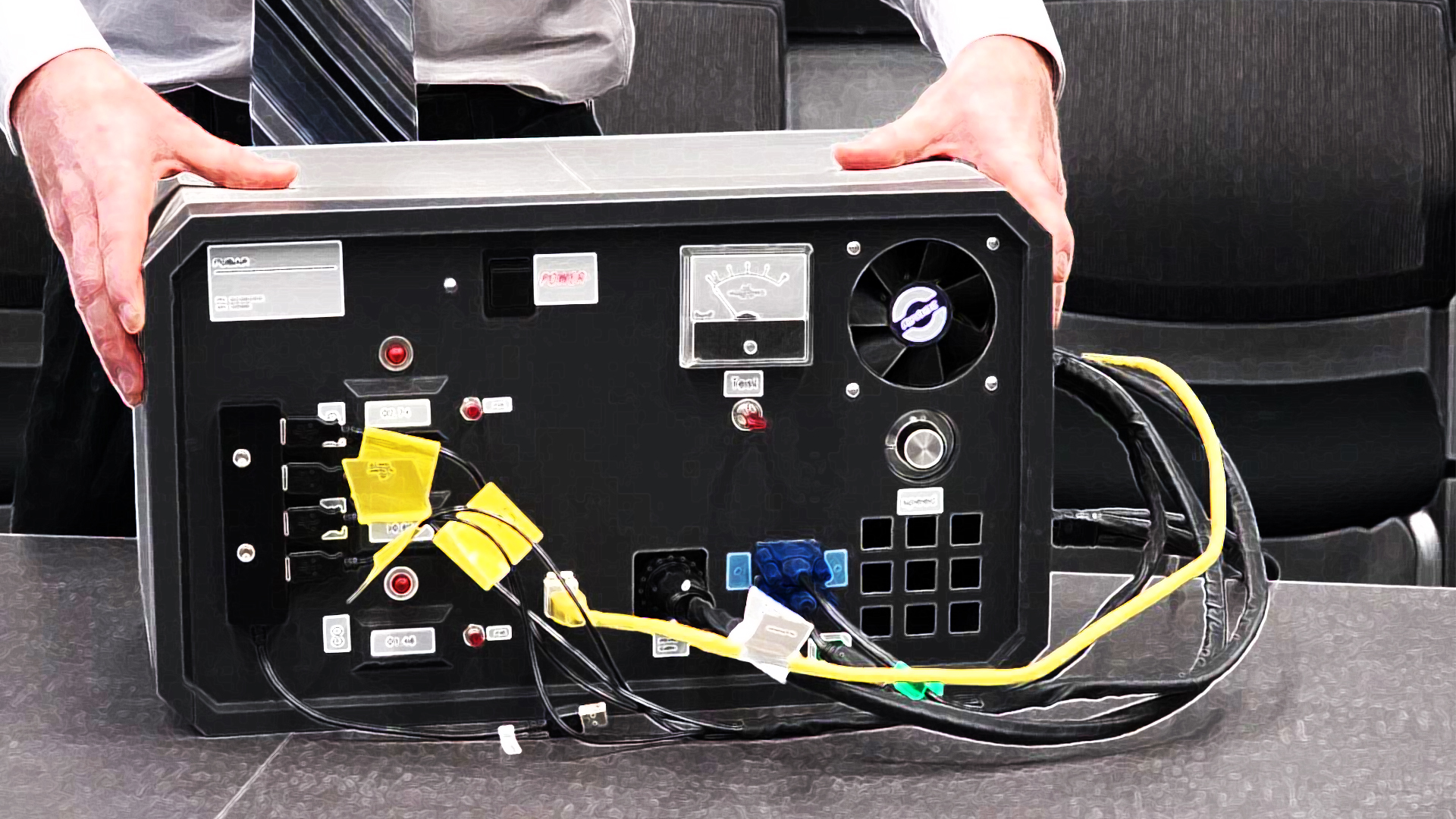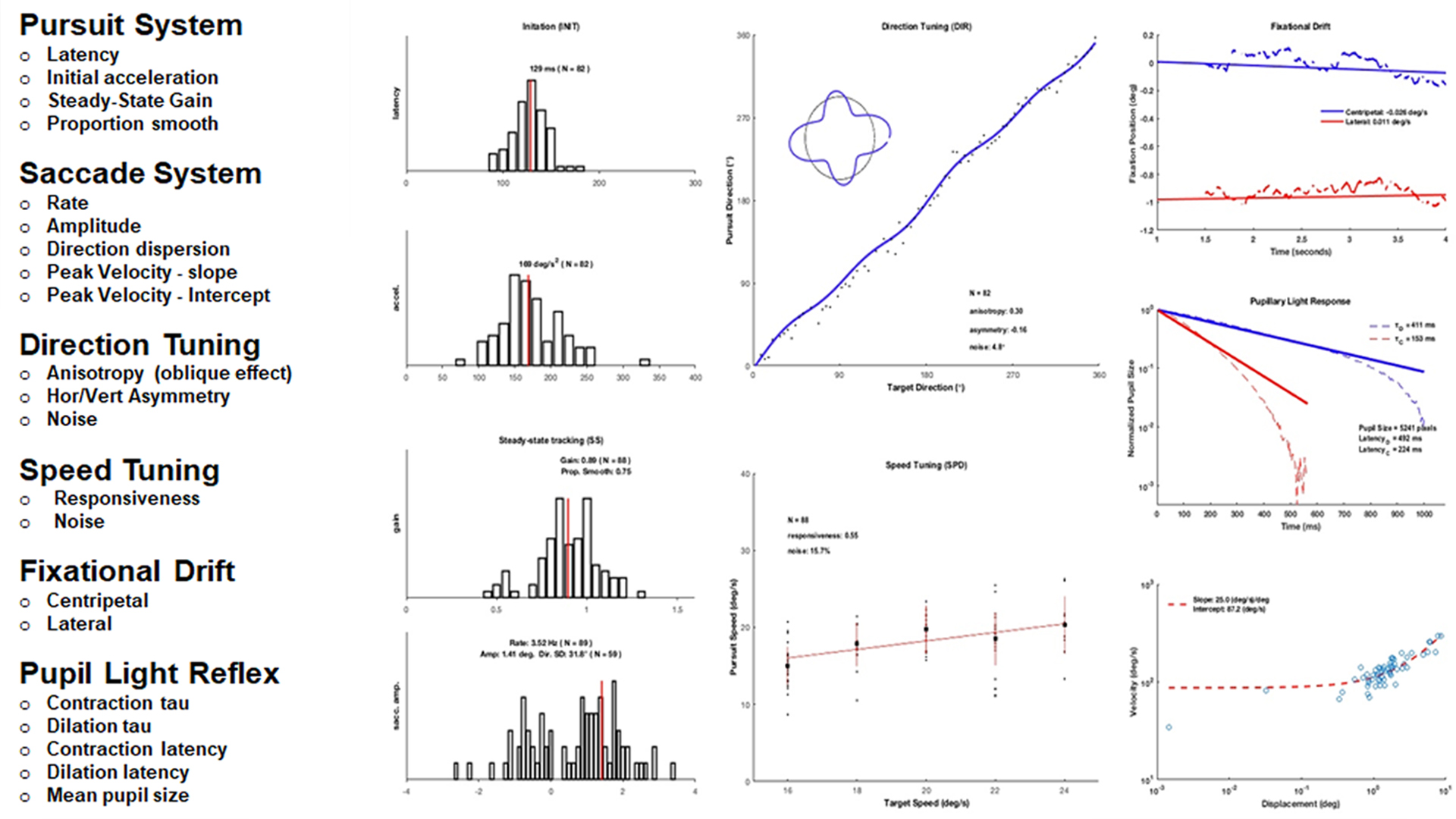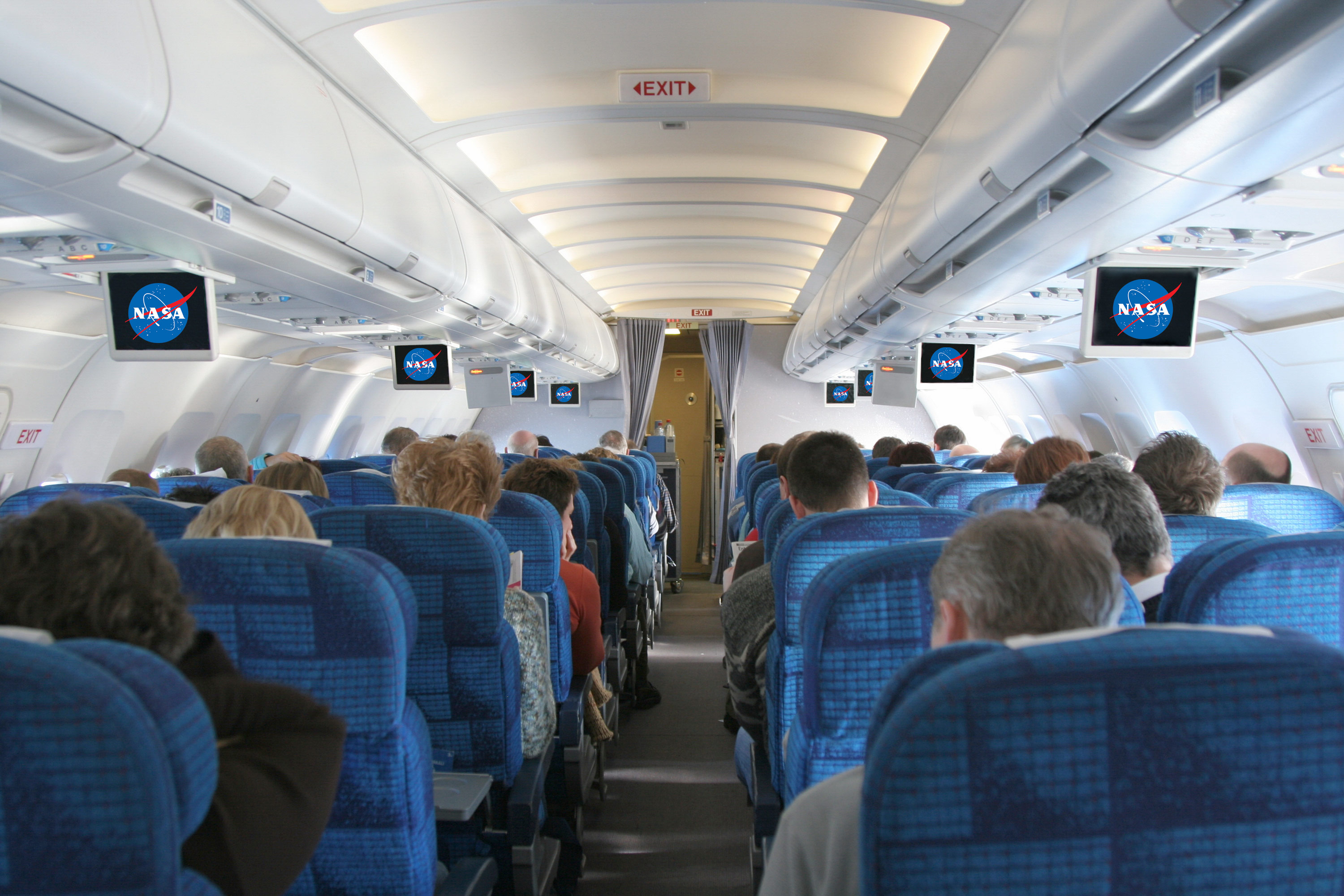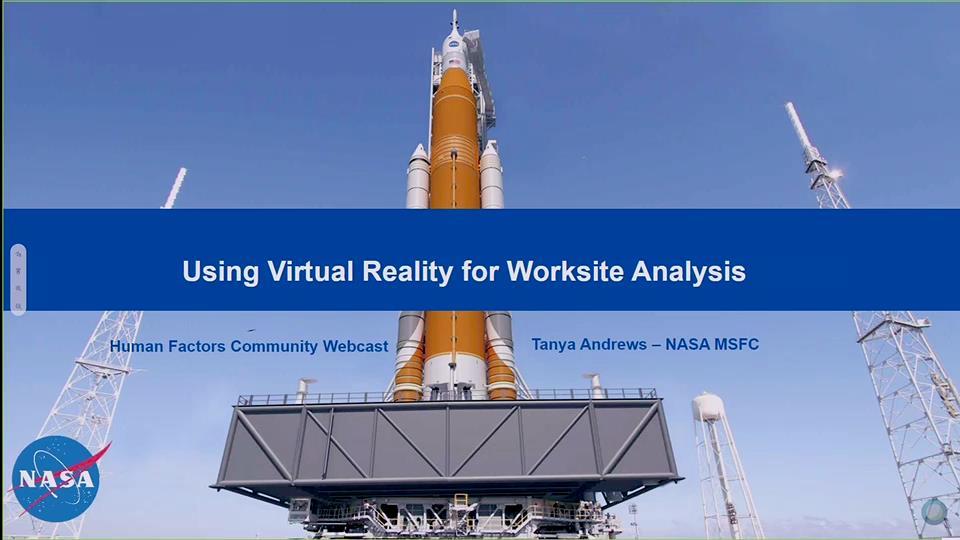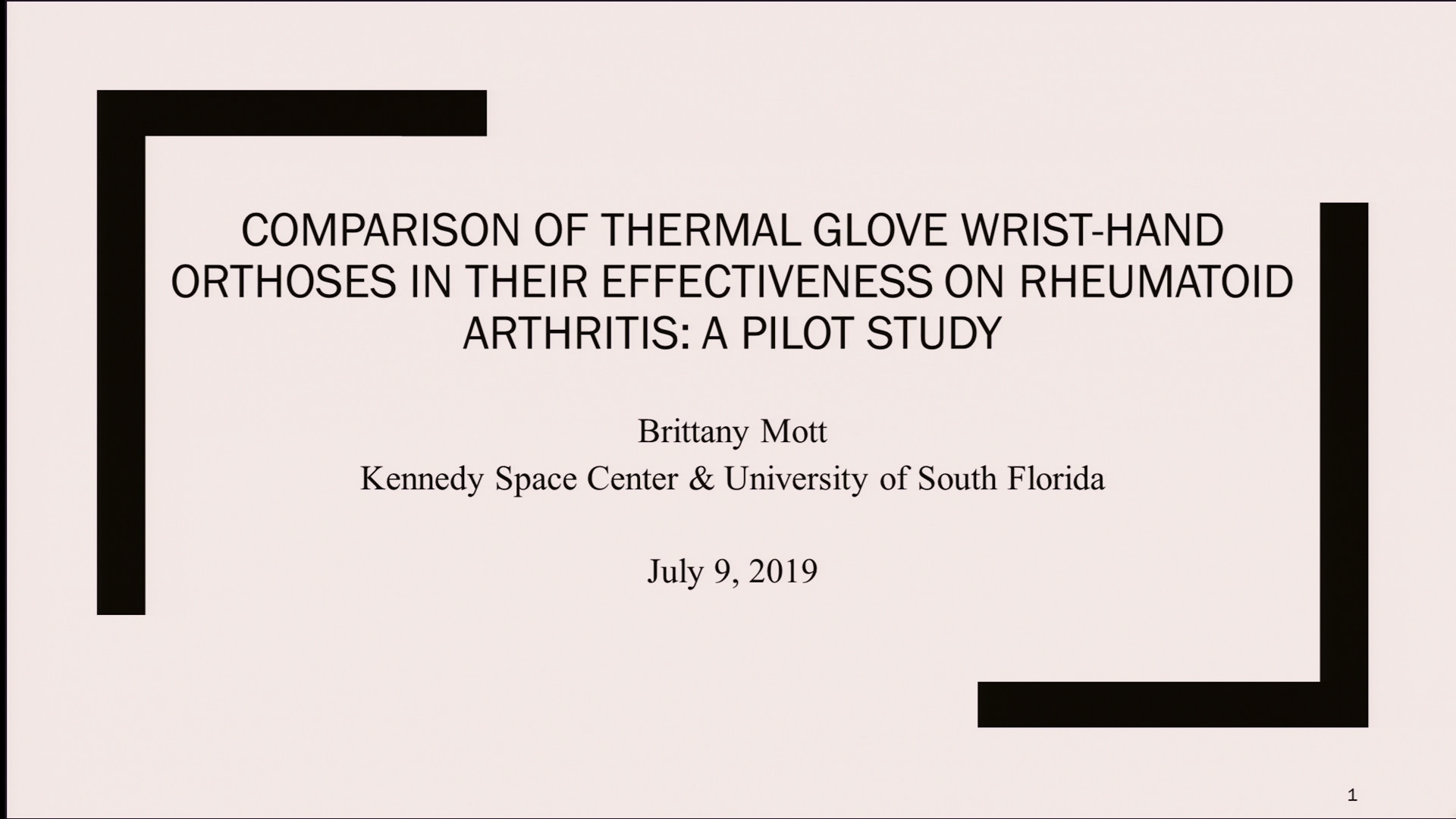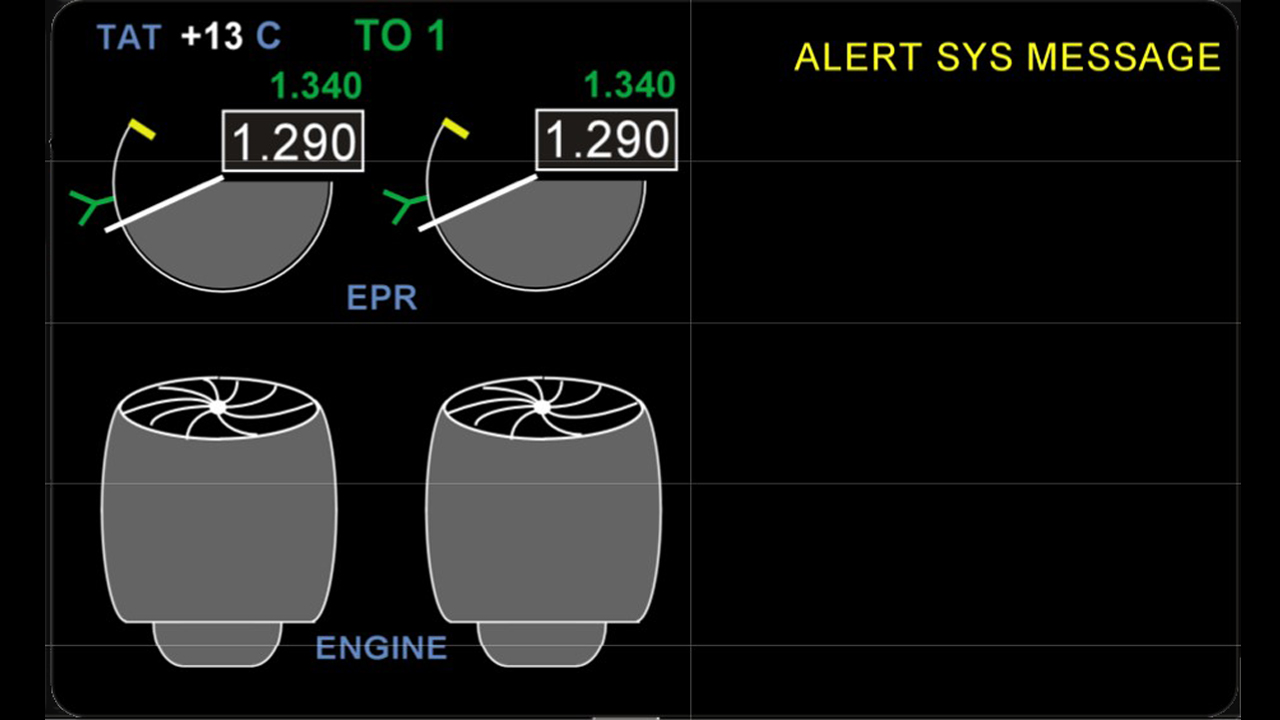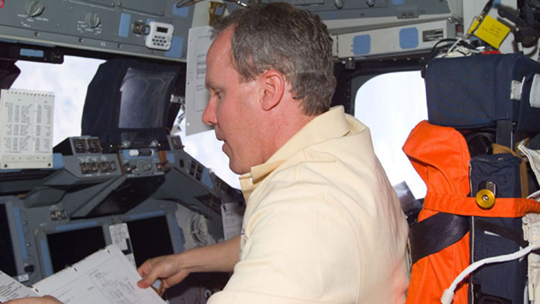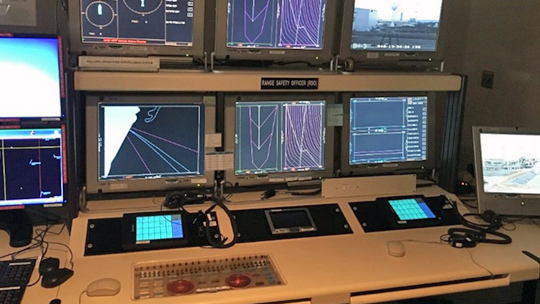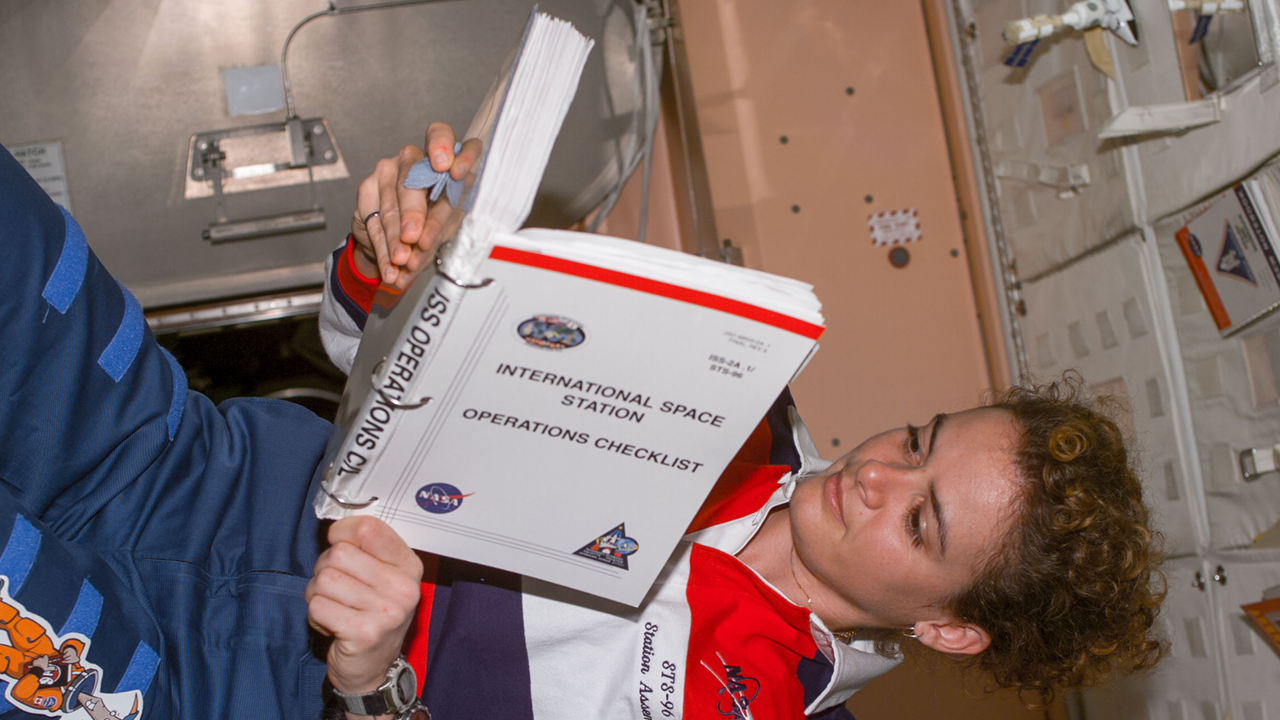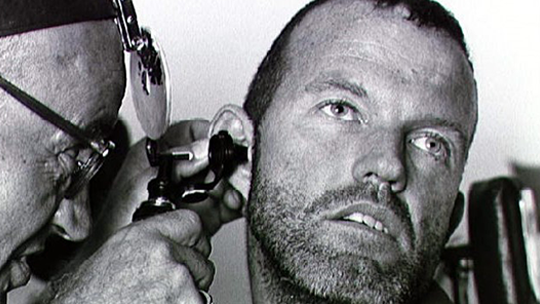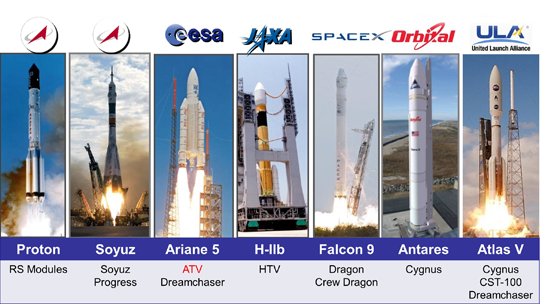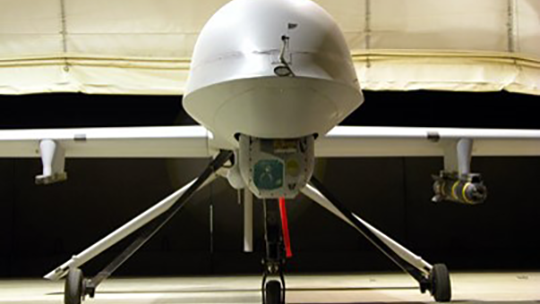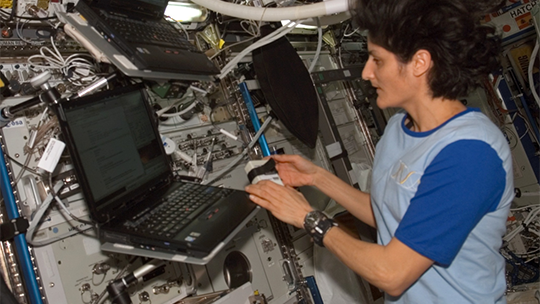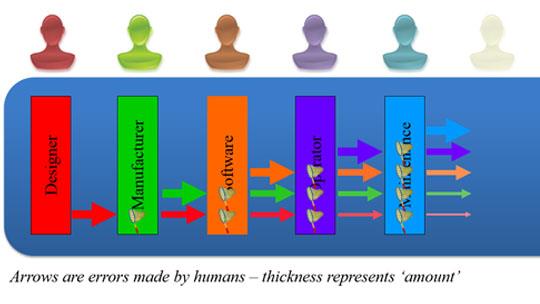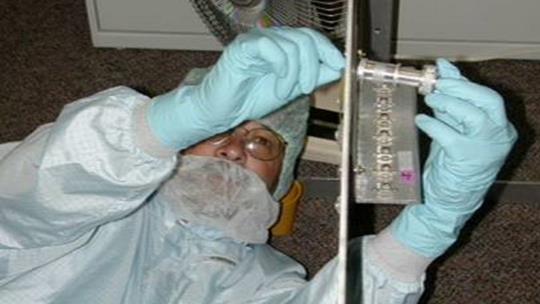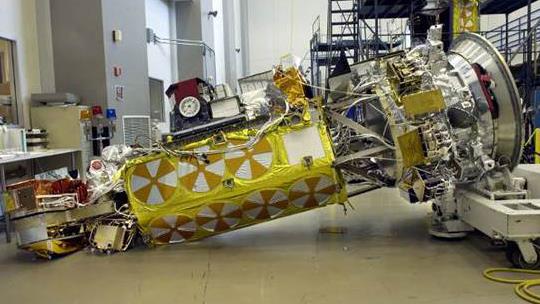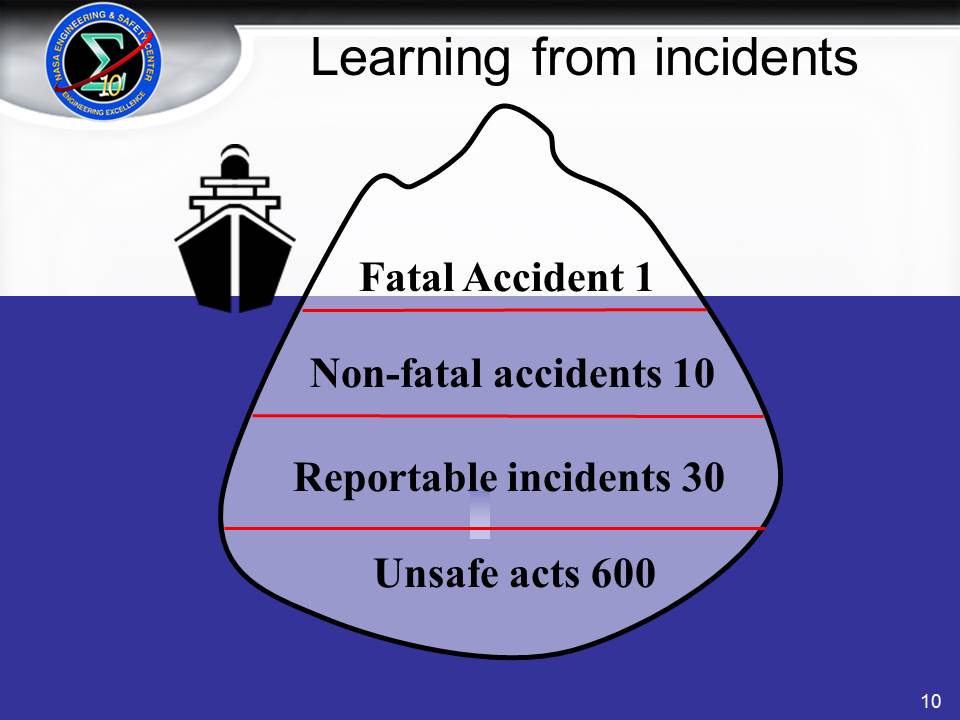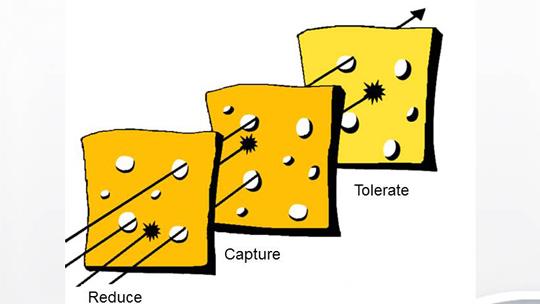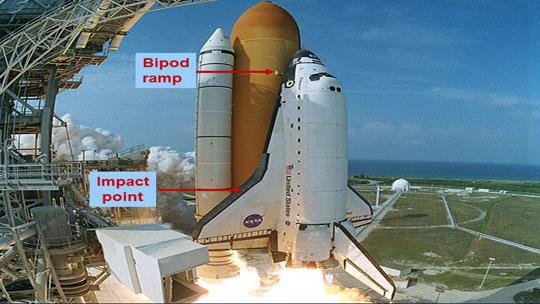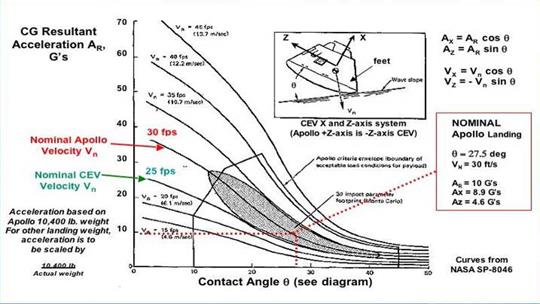Human Factors
49
These training modules were compiled by the Human Factors Discipline Team (TDT). The discipline of Human Factors advances human-centered design and operations of complex aerospace systems through analysis, experimentation, and modeling of human capability and performance. Practice of the Human Factors discipline has made dramatic improvements in safety, efficiency, and mission success.
Upcoming Webcasts
TBD
Checking for webcasts...
The Visual Experience at the Lunar South Pole
| Presenter | Charles Dischinger |
|---|---|
| Published | December 2023 |
| Recorded | December 2023 |
| Duration | 01:10:35 |
| Tags | #Fundamental, .Analysis / Modeling and Simulation, .Design, .Operations, .Lessons Learned, .Environments, .Systems / Subsystems, ~Lunar South Pole, ~Visual Experience, ~Human Vision, ~Lighting, ~Natural Environments, ~Spacesuit Design |
NASA’s Artemis Campaign intends to return humans to the moon in the coming years, with the intent to explore and establish permanent human presence there. The targeted landing and habitation sites are at the Lunar South Pole (LSP). These sites experience very different lighting conditions from those in the Lunar middle latitudes, where the Apollo landings occurred, which typically are in full sun for half the lunar day (approximately twenty-nine earth days). At the poles, the sun is never high in the sky. It never gets above seven degrees in elevation, at the sites being considered, and it is more often only one or two degrees above the horizon. As a result, the visual experience for the astronauts who explore and live there will be very different from that which the Apollo astronauts encountered. Those earlier missions were planned such that the sun was far above the astronauts, for most or all of their time on the surface. In contrast, at the LSP, the sun will often be in their field of view, and the shadows will be extremely long, when they face away from the sun. Their visual systems will be stressed by high intensity and glare and then often need to adjust to extreme darkness. Since the human eye does not make such shifts rapidly, highly capable lighting systems must be carefully designed. The NASA Engineering & Safety Center (NESC) is studying the problem, to characterize the extremes that astronauts will encounter and help programs characterize the lighting systems and glare protection that will be needed for safe surface operations. This presentation will describe the natural environments and the attempts to simulate the visual experience. It will also explain the risks derived from the lighting environment, for the mission goals currently planned and the kinds of new capabilities in simulation and surface equipment that will support those mission goals.<br><br>Speaker Biographies:<br><br>Charles Dischinger - Charlie joined the NASA Marshall Space Flight Center in 1994, as his third career. He was fortunate enough to be married to someone NASA needed. He has worked on human factors design for the International Space Station, for EVA and IVA systems. He was a systems engineer for Gravity Probe B. He worked on requirements development for the Constellation Program and at Headquarters, in the Office of Safety and Mission Assurance. On his return to MSFC, he became the team lead for the Human Engineering Assessment Team, and then the deputy to the Technical Fellow for Human Factors. Throughout his NASA tenure, he has worked on some of the most interesting efforts imaginable, in which he has been propped up and made to look presentable by many of the smartest people in the world; don’t think he doesn’t know it and appreciate it.<br><br>Mary K. Kaiser - After 30 years as a research psychologist in the Human Systems Integration Division at NASA Ames Research Center, Mary K. Kaiser now serves as a consultant to the Human Factors Technical Discipline Team of the NASA Engineering & Safety Center. Mary received her Ph.D. in psychology from the University of Virginia, and was a postdoctoral fellow at the University of Michigan in applied experimental psychology before joining Ames in 1985. The author of over sixty articles and chapters on perceptual psychology and human factors and a Fellow of the Association for Psychological Science, Mary also served as an associate editor of the Journal of Experimental Psychology: Human Perception and Performance (1998 – 2009) and as Project Scientist for NASA’s Space Human Factors Engineering Project (2009 – 2013). She holds two patents for innovative display technologies. Mary lives with her husband, Franz, near Portland, Oregon. Their two sons had the audacity to grow up and move out of the house. <br><br>
Human/Machine Teaming: Dancing with the Bear
| Presenter | Paul Schutte |
|---|---|
| Published | August 2023 |
| Recorded | August 2023 |
| Duration | 01:00:36 |
| Tags | None |
Discipline: Human Factors<br><br>Abstract:<br>With the advent of Foundation Models (e.g., large language models like ChatGPT) and stunning successes such as AlphaGo’s creation of a new and surprising winning strategy, dire predictions of human obsolescence have reemerged. However, current developments are in line with past AI trends which suggest that AI will be amazing but with regard to real-world operations (i.e., not games), there will still be a non-negligible (10-20%) portion of operations where AI will perform poorly or simply fail. These situations will continue to require a human to make the overall system work successfully. In a previous academy talk, I discussed how best to use a human not only in these situations but many others as well. In this talk I will expand on certain aspects of human/machine teaming including how to make the most of your machine.<br><br>About the Presenter:<br>Paul Schutte is a Principal researcher in Human-Machine Teaming in Applied Cognitive Science at Sandia National Laboratories in NM. He has worked at Sandia for 5 years. He is currently leading research efforts in Human Machine Teaming with regard to Foundation Models (e.g., GPT) and Machine Learning, Function Allocation, Trust, and Transparency. Prior to Sandia, he worked 35 years for NASA LaRC developing AI decision aids and cockpit interfaces for commercial aviation. He has expertise in Human-Machine Teaming, Naturalistic Decision Making, Function Allocation, and Aviation. Schutte has a MS in Experimental Psychology and an MS in Computer Science.
Crew Health and Performance System Probabilistic Risk Assessment (Chp-Pra): Proof-of-Concept Approach
| Presenter | Lauren McIntyre |
|---|---|
| Published | June 2023 |
| Recorded | September 2021 |
| Duration | 58:24 |
| Tags | #Intermediate, .Analysis / Modeling and Simulation, ~Modeling and Simulation, ~Crew Performance, ~Crew Health, ~Probabilistic Risk Assessment, ~Monte Carlo, ~Risk Quantification, ~Long Term Health |
Discipline: Human Factors<br><br>This presentation will give an overview of the proof-of-concept approaching being taken to quantify Crew Health and Performance (CHP) risk. By leveraging existing, robust tools for medical risk quantification (MEDPRAT), we present an approach for integrating CHP system capabilities in a manner consistent with other NASA risk characterizations that allows for trades on mass and volume.
Gecko Mobility Aids for A Common Habitat Architecture
| Presenter | Dr. Robert Howard |
|---|---|
| Published | May 2023 |
| Recorded | March 2023 |
| Duration | 42:30 |
| Tags | None |
Instructions:<br>- Please register to be kept in the loop should a schedule change occur.<br>- Add this to your calendar for a convenient 15-minute reminder.<br>- Slides and confirmation of attendance will be available to download approximately 30 minutes prior to the event. Refresh this page if not yet visible.<br>- Please submit questions as they arise rather than waiting until the end.<br>- Enjoy!<br><br>Abstract:<br>“Spacecraft large enough for crew to move around inside them have traditionally used handrails and foot restraints to enable crew mobility. The mass of this hardware can become significant in large spacecraft such as the Common Habitat. Additionally, handrails and foot restraints in a multi-gravity habitat are trip hazards when the habitat is in a gravity environment. Further, ISS crew have noted risks of breaking ankles and wrists when using handrails for translation and have noted places where not enough handrails are present. Robotic gecko-derived grippers developed by JPL to retrieve satellites can be adapted to crew-worn pads that can adhere to surfaces to enable crew translation in microgravity. <br><br>This technology will help to eliminate the need for handrails and foot restraints for mobility in crewed microgravity spacecraft cabins. It has the potential to achieve significant mass reductions in future space habitats, with application to suborbital flight, LEO, cislunar space, interplanetary space, the Moon, and Mars. Additionally, it can prevent crew injury and discomfort. Project goals and objectives are to prepare gecko uniform prototypes for use in multi-gravity testing and conduct initial investigations into human factors of postures and motions needed for intravehicular activity (IVA) translation and restraint in multiple gravity environments, without the use of handrails or foot restraints. Gecko grippers have been tested for use as robotic end effectors terrestrially, on microgravity aircraft, and aboard the ISS.<br><br>Using the grippers as a body-mounted system to achieve IVA crew mobility is a new application that has not been pursued outside of this effort. This work will continue paper studies performed by NASA student interns by developing physical prototypes of spacecraft crew uniforms with gecko-derived body-mounted grippers. Clothing prototypes may include long sleeves, short sleeves, long pants, shorts, gloves, and/or booties equipped with gecko gripper pads. Forward work is to test these uniforms in a 1g environment to verify that the design does not introduce obstructions, trip hazards, or other consequences when used in terrestrial gravity. Based on the 1g test results, the uniform prototypes will be refined, and a test plan developed for testing at 0g, (1/6)g, and (3/8)g.
NASA Marshall Space Flight Center Human Systems Integration of the Mars Ascent Vehicle
| Presenter | Tanya Andrews |
|---|---|
| Published | February 2023 |
| Recorded | February 2023 |
| Duration | 01:01:15 |
| Tags | None |
Instructions:<br>- Please register to be kept in the loop should a schedule change occur.<br>- Add this to your calendar for a convenient 15-minute reminder.<br>- Slides and confirmation of attendance will be available to download approximately 30 minutes prior to the event. Refresh this page if not yet visible.<br>- Please submit questions as they arise rather than waiting until the end.<br>- Enjoy!<br><br>Abstract:<br>The Mars Sample Return Campaign is a complex system, that includes two landers and two rovers, an orbiting return vehicle, and the Mars Ascent Vehicle (MAV). NASA Marshall Space Flight Center is responsible for MAV and is working with the Jet Propulsion Laboratory and Lockheed Martin to complete this part of the multi-year campaign. Human Systems Integration (HSI) of the MAV is paving the way for HSI in unmanned missions, as MAV is one of the first projects to officially be mandated to have an HSI plan, as directed through NASA Procedural Requirements. The Marshall HSI lead has needed to be flexible and innovative, in the face of changing requirements and evolving management strategies. <br><br>The HSI plan has had to be adaptive to these changes, while continuing to be useful and valuable to the SE team and to project management. The fact that the project has continued to rely on the HSI approach, despite outside argument that this focus was unnecessary, has only proven the value of HSI in such systems. This presentation highlights the plan and the path that led to the current status.
Some Theoretical Considerations for Autonomous Vehicle Design
| Presenter | Asaf Degani |
|---|---|
| Published | December 2022 |
| Recorded | October 2022 |
| Duration | 01:03:37 |
| Tags | #Intermediate, .Design, ~Framework, ~Ethical Rules, ~Trolley Problem, ~Ethical Decision Making, ~Autonomous Vehicle Behavior, ~Guidelines For Rule Development, ~Dynamic Control Systems, ~Public Space |
Instructions:<br>- Please register to be kept in the loop should a schedule change occur.<br>- Add this to your calendar for a convenient 15-minute reminder.<br>- Slides and confirmation of attendance will be available to download approximately 30 minutes prior to the event. Refresh this page if not yet visible.<br>- Please submit questions as they arise rather than waiting until the end.<br>- Enjoy!<br><br>Abstract:<br>Growing numbers of cities and companies are beginning to deploy state of the art technologies and services such as autonomous cars, robot taxis, delivery- and maintenance-robots, moving information kiosks and others. As a consequence, it is expected that the public space where people, cars, and robotic systems interact will need to undergo transformations to accommodate these new entrants. This accommodation is not only related to the technology per se, but also involves people’s grasp of how these “automated beings” are to act, interact and move (i.e., “behave”) in the public space. One of the most crucial aspects of this deployment involves defining new “rules of the road” that embody ethical considerations. With the entry of robotic “beings” into the public space and focus on ethical behavior and its practical encoding in the vehicle’s software, there is an opportunity to make tomorrow’s public space more equitable and accommodating for all. <br><br>This talk presents a framework and methodology for developing ethical decision making in the context of autonomous vehicle behavior (part of a soon to be published ISO standard 39003). One of the advantages of this methodology is that it can take any set of ethical values (e.g., the United Nations’ universal values, the Bioethics code of conduct, etc.). The selected set act as general guidelines for rule development and criteria for formal evaluations. I will discuss the issues involved in defining ethical rules for a variety of use cases such as lane changes in dense traffic, determining priority in vehicle-to-vehicle interactions, negotiations in ambiguous situations, and more. For each, I will describe the methodology and processes leading up to an “ethical” driving rule. I will also briefly touch on the philosophical “trolley problem” example and suggest a way to resolve it in the context of dynamic control systems.<br>
Creativity - A Human Factors Challenge
| Presenter | Dr. Lorenz Prasch |
|---|---|
| Published | November 2022 |
| Recorded | October 2022 |
| Duration | 01:02:33 |
| Tags | #Intermediate, .Other, ~Creativity, ~Ideas, ~Automation, ~Cognition |
Our world is changing rapidly, and work follows suit. Considering the traditional division of work in physical and mental labor, it is primarily physical labor that has been systematically analyzed and optimized over the last century. This made it possible to break down many manual tasks into small entities that could eventually be automated. This widespread automation is one of the main drivers of a changing world of work. While non-routine tasks have been considered fairly safe from automation in the past, recent advances in cognitive computing and artificial intelligence suggest that mental work might be next in line. In fact, some basic cognitive tasks have already been automated. A final frontier on the road towards ubiquitous automation, however, seems to be the generation of creative ideas. This suggests that the human capability to create will become increasingly important. <br><br>The present talk therefore aims to characterize creativity and its role in the modern workplace. Starting form a shared understanding of what creativity is, we examine the different areas in which human factors/ergonomics can support creative work. More specifically, we take stock in how creativity can be measured, analyze the pitfalls these types of measurement entail, and show how creativity support systems are now a staple in HMI Design. Concluding, human factors/ergonomics is recognized as particularly suited discipline to tackle creativity measurement and amplification in a human-centered way.
Modern Technology Meets Ancient Wisdom to Address Back Pain - Using Wearables to Track and Improve Posture
| Presenter | Dr. Bjorn Kruger |
|---|---|
| Published | September 2022 |
| Recorded | September 2022 |
| Duration | 01:01:57 |
| Tags | #Fundamental, .Design, ~Ergonomics, ~Back Pain, ~Office, ~Posture |
In industrialized societies, a huge percentage of the population suffers from back pain. Back pain is the largest contributor to decline in productivity of workers, and costs $200 - $600 billion per year in the United States.<br><br>The Gokhale Method® addresses back pain by teaching postural modifications. Crowdsourcing data shows the method to be an outlier in effectiveness for back pain. To support posture training, we developed SpineTracker™ and PostureTracker™, two wearable devices which provide real-time posture feedback to the student. SpineTracker is a five sensor unit that accurately shows the shape of the lumbar spine; PostureTracker is a two sensor unit that helps students to catch themselves when they depart from a personal ideal. <br><br>During our presentation, we will give an introduction to the principles of the Gokhale Method and provide an overview of our research based on our wearables."<br>
Learning From All Operations: Conceptual Framework
| Presenter | Tzvetomir Blajev |
|---|---|
| Published | June 2022 |
| Recorded | June 2022 |
| Duration | 55:49 |
| Tags | #State of the Art, .Lessons Learned, ~Systems Integration, ~Operations, ~Safety, ~Framework |
This webcast discusses the Flight Safety Foundation conceptual framework and common language for safety learning. The new framework is needed because the existing language of safety is predominantly built around learning from failures and cannot express learning from success. However, the new framework is unitary - it is not just a new framework to learn from success but it is an integral framework to learn from all that happens. The integral nature of the framework has also another dimension - it allows the relationship between safety and system objectives like efficiency to be made explicit. This lays the foundation of an approach that can best balance safety and system objectives like efficiency and sustainability.
Facilitating (and not Interfering with) Work System Resilience with New Technology
| Presenter | Emily Patterson |
|---|---|
| Published | May 2022 |
| Recorded | April 2022 |
| Duration | 51:31 |
| Tags | #Intermediate, .Design, ~Design, ~Automation, ~Resilience, ~Complex Systems, ~Work System, ~Technology, ~Communication, ~System Evaluation |
Traditionally, the negative unintended consequences of introducing new technologies into complex systems have not been explicitly assessed and mitigated. Recently, our understanding of how to identify, protect, and facilitate sources of resilience in a work system has advanced. In particular, there are lessons learned from two case studies of technologies: 1) voice loops, an auditory shared space that supported NASA Johnson communication and coordination, and 2) the introduction of bar coding in the medication administration process throughout the Veteran’s Health Administration. BCMA was designed to improve patient safety by reducing medication errors at the time of medication administration. <br><br>During and after implementation, there were unintended consequences on the ability of work systems to: 1) have a shared awareness of demands and deviations, 2) progressively respond to changing circumstances, 3) guide local control with policies and procedures, 4) flexibly adapt by reducing constraints on actions, and 5) coordinate across the system.
Success in Spaceflight: The Human System
| Presenter | Andrew Chaikin |
|---|---|
| Published | April 2022 |
| Recorded | March 2022 |
| Duration | 01:02:35 |
| Tags | #Intermediate, .Lessons Learned, ~Human Behavior, ~Failure, ~Group Think, ~False Perceptions, ~Leaders, ~Success Culture |
Instructions:<br>- Please register to be kept in the loop should a schedule change occur.<br>- Add this to your calendar for a convenient 15-minute reminder.<br>- Slides and confirmation of attendance will be available to download approximately 30 minutes prior to the event. Refresh this page if not yet visible.<br>- Please submit questions as they arise rather than waiting until the end.<br>- Enjoy!<br><br>Abstract:<br>What are the keys to success in spaceflight projects? What are the causes of failure? In this most unforgiving of human endeavors, the surprising answer is that the “rocket science” isn’t the hardest part. Ultimately, it comes down to how we think about the work, and the human behaviors that shape how we do the work. Success is critically dependent on such variables as whether or not we maintain a balance between ego and humility, and whether we remain open to new information that conflicts with our world view. It hinges on whether we indulge—even unconsciously—in all-too-common human behaviors like false perception of risk, hubris, groupthink, and that bane of technical organizations called the Not Invented Here syndrome. In spaceflight, we cannot afford those indulgences: They can be fatal. Fortunately, there are time-tested modes of thinking and behaviors that enhance our chances for success, when we choose to rigorously employ them.
Human Centered Design Impact on Habitability and Mission Success
| Presenter | Michal Ziso |
|---|---|
| Published | March 2022 |
| Recorded | March 2022 |
| Duration | 59:58 |
| Tags | #Intermediate, .Design, ~Human Centered Design, ~Habitability, ~Human Performance, ~Space Environments, ~Habitat Design, ~Space Vehicles |
Architecture and the built environment have the power to influence and shape the way humans think, feel and ultimately perform. Those creating these environments have the power to ensure that the human impact is not only positive, but also one that contributes to habitability and mission success. Despite living in a fast-changing world - whether it be technology, social structures, climate, or human-centric factors - our built environment changes very slowly. This statement is valid on earth, and holds further significance in space. An interdisciplinary human centered design approach, offered by a diverse team of experts, could potentially aid in creating environments that meet the different goals, risks, challenges and astronaut personas for a specific mission. This talk will explore the potential influence of human centered design solutions on habitability and mission success from the perspective of both earth and space. From the efficiency of a standardized common solution to a tailored approach, the talk explores how human factors are incorporated into each
A Structure (and Examples) for Capturing Lessons Learned
| Presenter | Dr. Jesse Leitner |
|---|---|
| Published | January 2022 |
| Recorded | December 2021 |
| Duration | 57:04 |
| Tags | #Intermediate, .Lessons Learned, ~Lessons Learned, ~Root Cause, ~Local Lesson, ~Scenario, ~Fault Tree, ~Causal Factor |
In this talk, we will recommend a structure to be followed for lessons learned, to ensure that they are complete, valid, and based on the root cause(s) of the events, if understood. This structure will be followed up with several examples of lessons that come from electronic part and printed circuit board failures, anomalies, and acceptance challenges.<br><br>
Human Factors Design Considerations for Complex Systems
| Presenter | Dr. Daniel Wallace |
|---|---|
| Published | December 2021 |
| Recorded | November 2021 |
| Duration | 58:13 |
| Tags | #Intermediate, .Design, ~Automation, ~Complex Systems, ~Human Error, ~System Design, ~Workload, ~Manpower, ~System Failure, ~Human Behavior, ~Off-Nominal |
Many automated/complex systems are ostensibly created to provide simplifying automation and reduce operator workload and manpower requirements. However, in doing so, designers introduce an increased likelihood of human error and overall system failure when off-nominal conditions arise. When automation is added to a system design the implications of those changes on human performance and human reliability (error potential) are often not understood or assessed. This talk will address human performance considerations when developing complex systems, especially with respect to non-deterministic human behavior under off-nominal conditions. We will also discuss methods for addressing human performance factors in reliability predictions for system modernization and automation.<br><br>
Design Factors & Safety in Air Transport
| Presenter | Martin Nijhof |
|---|---|
| Published | November 2021 |
| Recorded | October 2021 |
| Duration | 01:00:30 |
| Tags | #Intermediate, .Design, ~Aviation Design, ~Flight Safety, ~Incidents, ~Accidents, ~Human Centered Design, ~Mapping, ~Intuitive Design, ~Design For Error |
Design is omnipresent, and includes both good design and suboptimal, or even poor design. In the aviation domain, suboptimal design can affect the safety of flight. In this presentation a few examples of suboptimal design will be discussed using some case studies. In addition, a few design principles with some example of excellent designs will be presented.
Lumberjack Tradeoff Model: The Degree of Imperfect Automation
| Presenter | Dr. Chris Wickens |
|---|---|
| Published | October 2021 |
| Recorded | September 2021 |
| Duration | 59:00 |
| Tags | #Intermediate, .Design, ~Complex Systems, ~Nuclear Power, ~Meta-Analysis, ~Experiments, ~Automation Transparency, ~Degree of Automation, ~Taxonomy, ~Traffic Control, ~Failure Response, ~Collision Avoidance, ~Vertical Flight, ~Higher Level, ~Situation Awareness |
A taxonomy of automation support for human performance is presented that describes support at each of four stages of human information processing at different levels of automation authority. These two dimensions (stages and levels) combining to define the degree of automation. The effect of degree of automation is modeled to show that, mediated by loss of situation awareness, the higher degree of automation, the better performance of the human-AI team when all goes well, but the more problematic is the human response when automation fails. Hence the Lumberjack model: the higher the tree, the harder it falls. Data from a meta-analysis, and from an air traffic control and a NASA robotic arm simulation are presented to support the model, and to show how automation transparency can mitigate the fall of the higher tree.
Flight Deck Perspectives on the Complexity of Navigating in the Airport Terminal Area
| Presenter | Dr. Divya Chandra |
|---|---|
| Published | September 2021 |
| Recorded | September 2021 |
| Duration | 56:34 |
| Tags | #State of the Art, .Operations, ~Operations, ~Complex Systems, ~Navigation, ~Air Traffic Control |
Abstract:<br>In this talk, findings will be reviewed from a body of research we did to examine flight deck perspectives on the complexity of navigating in the airport terminal area, with an emphasis on operations that rely upon performance-based navigation (PBN). Arrival, departure, and approach paths designed to use PBN offer safety enhancements along with new levels of flexibility to negotiate terrain, airspace, and environmental considerations. <br><br>The initial goal of this research was to study the design, depiction, usability, and fly-ability of these paths and their associated aeronautical charts. Over time, the focus shifted towards how well these paths work in actual operations because there are several different sources of complexity that impact pilot tasks as they fly these routes. This research was funded by the FAA NextGen Human Factors Division (ANG-C1).<br>
A Digital Classification System to Assess Project Failures
| Presenter | Robert Moreland |
|---|---|
| Published | August 2021 |
| Recorded | July 2021 |
| Duration | 01:00:14 |
| Tags | #State of the Art, .Lessons Learned, ~Digital Classification Systems, ~Project Factors, ~Failure Classification Schemes, ~Multiple Disciplines |
Abstract:<br>Failure classification schemes are often used to categorize events that cause failures in projects. Despite the frequent publication of studies on project failure and success classification, there has been no analysis of failure classification schemes. Specifically, an open question concerns the similarities and differences of failure classification schemes between and within disciplines. Answering this question will provide insight into the applicability of a scheme across a range of disciplines and the challenges that may exist when multiple disciplines are collaborating on a project. Understanding the contents and nature of failure classification schemes is critical to improving theoretical study and practical implementation of schemes on projects. <br><br>The research presented in this presentation identifies 400 failure classification schemes through a systematic review, extracts over 4000 perceived causes of failure from the schemes as meta-data, and analyzes the schemes with a focus on disciplinary differences in the perceived causes of failure. Meta-analysis of the perceived causes of failure in the 400 failure classification schemes identifies that the content of failure classification schemes are diverse, both within and across disciplines. Significant differences are shown between schemes used in different disciplines. Within disciplines, the schemes show patterns in the perceived causes of failure that appear most frequently and there are some common perceived causes of failure among many disciplines. The findings of the research conclude that caution must be taken if applying a scheme across multiple disciplines.
The Power and Pitfalls of Language in Accident Investigation
| Presenter | Crista Vesel , MSc |
|---|---|
| Published | July 2021 |
| Recorded | June 2021 |
| Duration | 54:27 |
| Tags | #Advanced, .Other, ~Taxonomy, ~Linguistics, ~Attribution Error, ~Agentive Language, ~Forest Service |
Communication plays a powerful role in creating safety in all work environments. Effective language can lead to individual and organizational learning during pre-mission briefings, real-time activities, and post-mission analysis. However, the meaning of language is not constant - it changes based on the experience of the person, the context of the event, and the social construction of the communicators.<br><br>The language we use in accident investigations can impact how we make sense of events and whether we learn from them. Many factors can influence the review team during the collection of information and the writing of the report, such as our need for certainty in our lives, our inclination to assign agency, and our inherent biases. Accident reports often contain language that influences readers to make judgments that lead to simplistic blame, scapegoating, or even moral condemnation. Indeed, 'facts' are nothing without context, yet investigation language often closes the door to this rich world of information through its agentive descriptions, causal attributions, and use of taxonomies that place actions and decisions into pre-determined 'boxes'.<br><br>This presentation will help you become sensitive to the power and pitfalls of language in areas of your life that go far beyond accident investigation!
Human Factors in Learning from Adverse Events: The Importance of Understanding Situation and Context
| Presenter | Professor Ron McLeod |
|---|---|
| Published | June 2021 |
| Recorded | May 2021 |
| Duration | 55:42 |
| Tags | #Advanced, .Lessons Learned, ~Human Behavior, ~Blame, ~Performance, ~Risk, ~System |
The UK’s Chartered Institute of Ergonomics and Human Factors (CIEHF) recently published a White Paper on ‘Learning from Adverse Events’. The paper sets out 9 Principles representing good practice in investigating and learning about the Human Factors contribution to events. Central to those principles are the importance of understanding both the situation and the context in which people made decisions and acted. After briefly summarising the nine principles, the talk will explore in some depth the difference between what is meant by “situation” and “context” in learning from events. Using examples of major incidents for illustration, the talk will demonstrate how psychological insight can help achieve deep learning about the context of human behaviour and performance
Moving Gracefully from Compliance to Learning, the Beginning of Forest Service's Learning Journey
| Presenter | Dr. Ivan Pupulidy |
|---|---|
| Published | May 2021 |
| Recorded | April 2021 |
| Duration | 59:04 |
| Tags | #State of the Art, .Lessons Learned, ~Workplace Incidents, ~Accident Investigation, ~Culture Change, ~Behavior, ~Learning, ~Coordinated Response Protocol (CRP) |
The US Forest Service faced a crisis of trust that was undermining communications and information flow. The result was an abysmal accident rate. This talk will explore field initiatives and leadership actions that began to change the organization's approach to learning. Three key pillars will be introduced: The leadership safety journey, field initiatives to change the way the organization responded to accidents and incidents, and some of the research that underpinned the changes that took place.
Earth-Based Analogs & Modeling for Exercise Biomechanics in Space
| Presenter | Kaitlin Lostroscio |
|---|---|
| Published | February 2021 |
| Recorded | November 2018 |
| Duration | 36:33 |
| Tags | #Advanced, .Analysis / Modeling and Simulation, ~Exercise Performance, ~Biomechanics, ~Space Exercise, ~Vibration, ~Human Modeling, ~Computational Modeling, ~Kinetics |
Recorded December 12, 2018<br><br>The biomechanics of exercise in space is difficult to study and there are unknowns surrounding exercise performance on future space exploration countermeasures systems. These issues are beginning to be addressed through enhanced modeling techniques fueled initially by human-in-the-loop data collections in ground-based environments. The presentation will focus on an effort completed at the University of South Florida to apply the Computer Assisted Rehabilitation Environment (CAREN) system to address a human spaceflight need. The research explored the interaction between a human and a moving platform while exercise was completed. This enabled study of the effects a vibration isolation system may have on exercise form and loading in these future exploration exercise suites. The combination of motion and force data collected in various environments, paired with computational models, allows our understanding of the system to grow. These methods provide design requirements and allow device designs to be supported by analysis.
Miserable Risk Estimation: "Managing" Low-Probability, High-Consequence Risks"
| Presenter | Dr. Mary Kaiser |
|---|---|
| Published | January 2021 |
| Recorded | October 2020 |
| Duration | 01:02:04 |
| Tags | #Advanced, .Analysis / Modeling and Simulation, ~Risk Management, ~Risk, ~Risk Estimation |
As with all bold endeavors, NASA missions must identify and manage their risks. While estimating the consequences of these risks is typically straightforward, it can be challenging to estimate their likelihood. This is especially true for low-probability risks, due both to the lack of operational data and the cognitive biases humans bring to risk estimation. In this talk, I will present both a tongue-in-cheek and “Management Science” approach to estimating low-probability, high-consequence risks. I then summon my Human Factors colleagues to provide NASA mission managers with the gentle guidance needed to avoid common errors in risk assessment.<br><br>About the Speaker:<br>After 30 years as a research psychologist in the Human Systems Integration Division at NASA Ames Research Center, Mary K. Kaiser now serves as a consultant to the Human Factors Technical Discipline Team of the NASA Engineering & Safety Center. Mary received her Ph.D. in psychology from the University of Virginia, and was a postdoctoral fellow at the University of Michigan in applied experimental psychology before joining Ames in 1985.<br><br>The author of over sixty articles and chapters on perceptual psychology and human factors and a Fellow of the Association for Psychological Science, Mary also served as an associate editor of the Journal of Experimental Psychology: Human Perception and Performance (1998 – 2009) and as Project Scientist for NASA’s Space Human Factors Engineering Project (2009 – 2013). She holds two patents for innovative display technologies.<br><br>Mary lives with her husband, Franz, near Portland, Oregon. Their two sons had the audacity to grow up and move out of the house.
Shiftwork & Managing Fatigue
| Presenter | Irene Gregory |
|---|---|
| Published | January 2021 |
| Recorded | August 2020 |
| Duration | 01:03:08 |
| Tags | #State of the Art, ~Fatigue, .Lessons Learned, ~Assessment, ~Strategies, ~Performance, ~Shift Work |
Abstract:<br>There are physiological limits to human performance, influenced by the internal programming of the sleep homeostat and circadian rhythms. Shiftwork and working at irregular times of day present significant physiological challenges for individuals. This presentation will provide information about the physiology underlying fatigue, and provide some practical strategies for personal fatigue management, for better sleep and in managing alertness on the job.
Automation Myths and the Virtues of Human-Machine Teaming
| Presenter | Dr. Robert Hoffman |
|---|---|
| Published | July 2020 |
| Recorded | August 2018 |
| Duration | 41:15 |
| Tags | #Intermediate, .Other, ~Teamwork, ~Holistic View, ~Self Sufficiency and Self Direction, ~Allocation Myth, ~Task Allocation, ~Levels Of Automation Myth, ~Automation Myth, ~Compensation Myth, ~Substitution Myth, ~Workload Myth, ~Resilience Myth, ~Drone Case Study Example, ~Flexecution Model, ~Systemic Causes, ~Savings Myth, ~Shiny Objects Myth, ~Promise Of Automation Vs. Reality, ~Un-Fitts List, ~Theory Of Interdependence, ~Observability, ~Predictability, ~Directability |
A number of widely-held beliefs underlie much of the popular discussion about automation, and also many of the government funding programs aimed at developing advanced technology. These include myths about autonomy, function allocation, compensation for human limitations, and automation as a substitution for people. These myths are not only misleading, but can be costly because they engender a host of serious misconceptions for policy makers thinking and for engineers.<br><br>In this presentation we will review these myths and then counter them with the alternative view of human-machine teaming. This focuses design on teamwork, rather than taskwork. Specifically it focuses on interdependent activity, rather than independent work. It focuses on lifetime resilience rather than short-term procurement costs. Successful human-machine teamwork requires more than an engineering solution to the machine capabilities. It also requires a holistic view that takes into account the requirements of the entire human-machine work system in its application context.
Human Factors Applications of Biomechanical Modeling
| Presenter | Dr. Beth Lewandowski |
|---|---|
| Published | June 2020 |
| Recorded | June 2019 |
| Duration | 38:55 |
| Tags | #Advanced, .Analysis / Modeling and Simulation, ~Computational Modeling, ~Biomechanical Modeling, ~Injury Thresholds, ~Injury Risk, ~Task Performance, ~Operational Volume, ~Internal Loading |
Recorded June 18, 2019<br><br>Biomechanical data collection and modeling has applications to the field of human factors. Specifically, motion data can be used to determine the operational volume necessary for performing a task. The operational volume assessment can be performed in order to determine how much volume is needed to perform the task or if task performance can be contained and adequately performed within an allocated volume. Motion and external force data, along with computational modeling techniques, can be used to estimate the internal loading produced during performance of a task. Internal loading estimates can be used to determine if an adequate stimulus is generated for maintenance of musculoskeletal health and also for comparison to injury thresholds to determine injury risk during task performance.
Futuristic Habitat Concepts to Expand Human Capability in Space
| Presenter | Dr. Robert Howard |
|---|---|
| Published | June 2020 |
| Recorded | May 2020 |
| Duration | 59:34 |
| Tags | #State of the Art, .Design, ~Habitats, ~Space Vehicle Design, ~Lunar Lander, ~Mars Lander, ~Docking, ~Resupply Logistics, ~Crew Size, ~Human Spaceflight, ~Deep Space Science Vessel (DSSV) |
Since the dawn of human space flight there have been visions for human space flight programs that send humans to destinations beyond Earth. NASA is currently committed to the lunar surface, Mars surface, and deep space transport. Unfortunately, instabilities in US space policy have caused NASA to change focus repeatedly between these architectures since the 1970s. Further, it can be shown that developing lunar, Martian, and transit habitats in series will require inordinately long periods of time, resulting in exorbitant program expenses. A mitigation to these challenges could be to develop a Common Habitat design for both transit and surface operations. A Common Habitat derived from the Space Launch System core stage’s liquid oxygen tank and manufactured on the same production line as the SLS can be designed to provide functionality required for both microgravity transit and surface operations. Part one of this webcast will describe design considerations and options in addressing open challenges and unknowns as they pertain to horizontal or vertical interior orientation, integration with lunar or Martian landers, docking and resupply logistics, and variations in crew size.<br><br>Part two of this webcast introduces the idea of a transit spacecraft whose primary crew mission is found within the transit as opposed to the destination. This webcast introduces the concept of a Deep Space Science Vessel (DSSV), a large, multi-purpose, multi-disciplinary science spacecraft intended for human spaceflight operations in the inner solar system. This webcast will define the DSSV onboard crew functions and describe target performance levels for each function. It will then discuss the habitable volume of the spacecraft, providing high level workstation descriptions and preliminary layout options for portions of the spacecraft. Attached and typical visiting vehicles will be described, including their functions, heritage, and examples of mission-specific configurations. Mission concepts will be described for key missions possible within the vehicle’s operating range. Sample crew composition for the DSSV will be discussed. Finally, future work will be described, providing context for human development of the inner solar system.<br>
Practical Application of Human Factors in Flight Hardware Design
| Presenter | Sean Schimelpfening |
|---|---|
| Published | March 2020 |
| Recorded | January 2020 |
| Duration | 51:19 |
| Tags | #Intermediate, .Design, ~Hardware Design, ~Payload Design, ~ISS Payload, ~Human Factors Implementation Team (HFIT) |
Abstract:<br>The following presentation and corresponding hardware demonstration were developed as training for U.S. ISS Payload Developers (PDs), to instruct them how to design hardware to meet ISS Payload Human Factors requirements and guidelines, and to brief them about the services the ISS Human Factors Implementation Team (HFIT) offers to them. Applying Human Factors requirements and guidelines to flight hardware design is not as simple as one would think. This presentation and hands-on demonstration have proven valuable to get hardware developers to think about designing crew interfaces that are safe and easy to operate.<br>
Oculometric Assessment of Mild Neural Impairment
| Presenter | Dr. Leland Stone |
|---|---|
| Published | March 2020 |
| Recorded | January 2020 |
| Duration | 48:56 |
| Tags | #State of the Art, .Other, ~Assessment, ~Cognition, ~Decision Making, ~Performance, ~Measurement, ~Reaction Time |
Abstract:<br><br>For over 100 years, neurologists have used eye movements to identify neural impairment, disease, or injury. Prior to the age of modern imaging, qualitative assessment of eye movements was a critical, routine component of diagnosis and remains today a routine law-enforcement tool for detecting impaired driving due to drugs or alcohol. We will describe the application of a simple 5-minute oculomotor tracking task coupled with a broad range of quantitative analyses of high-resolution oculomotor measurements for the sensitive detection of sub-clinical neural impairment and for the potential differentiation of various causes. Specifically, we will show that there are distinct patterns of impairment across our set of oculometric parameters observed with brain trauma, sleep and circadian disruption, and alcohol consumption. Such differences could form the basis of a self-administered medical monitoring or diagnostic support tool.
Exploring Human Performance Contributions to Safety in Commercial Aviation
| Presenter | Dr. Jon Holbrook |
|---|---|
| Published | November 2019 |
| Recorded | February 2019 |
| Duration | 36:37 |
| Tags | #Intermediate, .Other, ~Research Study, ~Safety II, ~Decision Making, ~Safety Management, ~Human Operators, ~Pilot Interventions, ~Contingency Table, ~Human Intervention and Outcome, ~Safety I, ~Hollnagel, ~Work As Done, ~Work As Imagined, ~Future Operations, ~Protective Safety, ~Productive Safety, ~Resilience, ~Study Methods, ~FOOQA, ~Pilot And Traffic Controller Interviews, ~Strategies, ~Machine Learning (DT-MIL Algorithm), ~High Speed Exceedance Example, ~Recommendations |
Instructions:<br>- Add this to your calendar using the "Add to Calendar" link for a convenient 15-minute reminder.<br>- Slides are available to download in the "Links."<br>- Please submit questions as they arise rather than waiting until the end.<br>- Enjoy!<br><br>Abstract: <br>Data-driven decisions about safety management and design of safety-critical systems are limited by the available data, which influence, and are influenced by, how decision makers characterize problems and identify solutions. In the commercial aviation domain, data are systematically collected and analyzed on the failures and errors that result in infrequent incidents and accidents, but in the absence of data on behaviors that result in routine successful outcomes, safety management and system design decisions are based on a small sample of non-representative safety data. As a case in point, analysis of aviation accident data suggests that human error is implicated in up to 80% of accidents, which has been used to justify future visions for aviation in which the roles of human operators are greatly diminished or eliminated in the interest of creating a safer aviation system. However, failure to fully consider the human contributions to successful system performance in civil aviation represents a significant and largely unrecognized risk. Without understanding how humans contribute to safety, any estimate of predicted safety of autonomous machine capabilities is incomplete and inherently suspect.
Virtual Reality for Worksite Analysis Methods
| Presenter | Tanya Andrews |
|---|---|
| Published | October 2019 |
| Recorded | August 2019 |
| Duration | 32:03 |
| Tags | #Intermediate, .Testing, ~Design, ~Verification, ~Human Factors Engineering (HEF), ~Virtual Reality (VR), ~HFE Analyses, ~Space Launch System (SLS), ~Deep Space Habitat (DSH), ~Analysis, ~Analysis Tools |
Open to the Public<br>Recorded September 10, 2019<br><br>NASA Marshall Space Flight Center (MSFC) Human Factors Engineering (HFE) Team is implementing Virtual Reality (VR) into HFE analyses of various projects. MSFC HFE is responsible for the worksite analyses of the integration efforts of the Space Launch System (SLS) that will be performed at Kennedy Space center (KSC), as well as the HFE analyses of Deep Space Habitat (DSH) Concepts. There is a wide variety of tasks, and it is important to verify that the vehicle can be integrated at KSC early in the design process. If the ground support crew cannot complete the task, access the parts of the elements that require integration, or if other hardware may be damaged during such access, redesign efforts have to be implemented. MSFC HFE is responsible for this verification and has used methods such as drawing inspection, observation of tasks performed on test articles, and building physical mockups that are sometimes used with Motion Capture (MoCap). In addition, VR analyses are now being utilized for a faster analysis early in the process that can impact design before drawings are finalized and funds are allocated for physical mockups. This technology does not replace the need for physical mockups in most cases, but rather improves the design maturity of the physical mockup. All of these methods are used in tandem to perform HFE assessments at NASA MSFC.
Thermal Glove Wrist-Hand Orthoses and Rheumatoid Arthritis
| Presenter | Brittany Mott |
|---|---|
| Published | July 2019 |
| Recorded | June 2019 |
| Duration | 51:49 |
| Tags | None |
Rheumatoid arthritis (RA) is an autoimmune disease affecting nearly 1% of the world’s population with symptoms such as inflammation, pain, and reduced strength. Physicians and scientists work to develop pharmaceuticals and medical devices aimed at decreasing the symptoms associated with RA to better the lives of those affected. One of the most recent developments is the addition of thermal therapy gloves to the array of upper limb orthoses available to patients with RA. It was hypothesized that this study will show that orthoses in the form of thermal therapy gloves are beneficial to the patients by reducing symptoms such as pain and allowing them an increased range of motion and overall hand functionality. Patients in stage 2 were recruited and asked to first complete a personal history survey including the Health Assessment Questionnaire (HAQ) and Pain Catastrophizing Scale (PCS). Range of motion tasks and the Arthritis Hand Function Test (AHFT) were completed to determine the effect of two thermal therapy gloves on the range of motion and activities of daily living. This webcast will give an overview of the pilot study, results, and suggestions for future studies.
Human Factors Discovered: Stories from the Front Lines
| Presenter | Dr. Randy Mumaw |
|---|---|
| Published | November 2018 |
| Recorded | April 2018 |
| Duration | 56:16 |
| Tags | #Intermediate, .Lessons Learned, ~Research Studies, ~Nuclear Power, ~Plant Observations, ~Operator Monitoring, ~Model of Monitoring, ~Procedure Use, ~Human in the Loop Simulation, ~Problem Solving, ~Flight Interfaces, ~Pilot Failure Simulations, ~Engine Icing, ~Helios 522 Accident, ~Qantas A380, ~Engine Failure, ~Management of Non-Normals, ~Flight Deck Effects, ~Flight Capabilities, ~Error Detection, ~Identifying Design Weaknesses |
Recorded May 8, 2018<br><br>Randy has spent more than 3 decades thinking about how to improve human performance in complex, socio-technical systems. For most of that time, he was working with a system developer (Westinghouse or Boeing). That experience allowed him to be a witness to how human operators perform—what they do well and what happens that is different from what the system developer expected.<br><br>In this presentation, Randy will offer operational “stories” to illustrate how humans use technology in unanticipated ways and how system designers fail to understand how difficult system operation is. He will also discuss the dilemma of quantifying human performance. Larger Human Factors themes will emerge.
Method for Simulation of Procedure Performance
| Presenter | Dr. Lance Sherry |
|---|---|
| Published | December 2017 |
| Recorded | October 2017 |
| Duration | 51:16 |
| Tags | #Advanced, .Analysis / Modeling and Simulation, ~Standard Operating Procedures, ~Procedure Analysis, ~Data Analytics, ~Procedure Simulation, ~Allowable Operational Time Window (AOTW), ~Time-on-Procedure(ToP), ~Procedure Buffer Time (PBT) |
Recorded October 24, 2017<br><br>Airline Standard Operating Procedures (SOP) define the sequence of flight crew actions to handle the set of mission situations that can emerge in the execution of a commercial airline flight. Each SOP must be completed within an Allowable Operational Time Window (AOTW) to avoid a hazardous outcome. For dynamic plants (e.g. airliner) the Time on Procedure (ToP) and the AOTW are distributions that vary with the interactions between environment, plant, and operator actions. <br><br>Making sure that new, or modified procedures, can be completed in a timely manner (i.e. ToP AOTW) is a critical step in verification of SOPs. This presentation describes a method to simulate the time distributions for SOPs. A case study analysis of the Take-off procedure is demonstrated resulting in a simulated ToP within 5% of the actual. The implications of these results for testing procedure design and limitations of this method are discussed.
“ABORT! ABORT!” - Applied Human Factors for Time-sensitive, Safety Critical Systems
| Presenter | Ronald Daiker |
|---|---|
| Published | December 2017 |
| Recorded | September 2017 |
| Duration | 56:58 |
| Tags | #Intermediate, .Design, ~Wallops Flight Facility (WFF), ~Safety Critical Range Data Display System (RDDS), ~Time-Sensitive, ~Safety Critical Systems, ~Launch Facilities, ~Launch Operations, ~Arm/Destruct Decisions, ~Cognitive Task Analysis, ~System Satisfactory Survey, ~User Interface Design, ~Human Systems Integration (HSI), ~Applied Human Factors, ~Human Factors Techniques, HSI Lessons Learned |
Air date: November 14, 2017<br><br>A team of human factors researchers from NASA Langley Research Center have completed a four-month study aimed at improving the user interface of the Wallops Flight Facility (WFF) Safety Critical Range Data Display System (RDDS) used to support arm/destruct decisions during launch operations. WFF representatives reached out to Langley's Crew Systems and Aviation Operations Branch (CSAOB) for assistance in the area of user interface design, and the resulting study was funded by the NASA Engineering and Safety Center (NESC). Lisa Rippy (D2), Ron Daiker (D318), Rania Ghatas (D318), and Michael Vincent (D318) have been collaborating with WFF personnel to develop data driven, user-centered software requirements in support of the WFF software re-design effort. The LaRC research team was invited to brief their findings to WFF Range and Safety leadership on August 9, 2017. Representatives from WFF commended the LaRC research team for their efforts and expressed interest in an on-going partnership between LaRC and WFF throughout the design, development, and fielding of the new Launch Termination System Software.<br><br>This presentation will focus on the applied human factors methods and techniques employed to respond to this request for assistance within the agency, and the lessons learned from this study. As ambassadors for the human factors discipline, practitioners should always be prepared to answer the call for assistance from others both within and outside of the agency. The ability of HF practitioners to effectively represent the discipline and add value to a project is critical for the future growth and sustainment of the discipline. The role of applied human factors within the agency will also be discussed, along with recommendations which would benefit similar efforts in the future.
Training for Generalization in Technical Domains
| Presenter | Dr. Dorrit Billman |
|---|---|
| Published | September 2017 |
| Recorded | July 2017 |
| Duration | 53:02 |
| Tags | #State of the Art, .Lessons Learned, ~Operations, ~Research, ~Training, ~Skills, ~Mission |
Recorded August 8, 2017<br><br>Applying what you know in new situations, for new goals, or with different resources is a hallmark of successful learning. Generalizing what you know and transferring your skills and knowledge to new settings will be a key success factor in future long-distance exploration missions. In work domains relying on use of complex technology, we propose that these three types of skills and knowledge enable generalization: a) a mental model of a device, b) procedures for carrying out work using the device, and particularly, c) an integrated understanding of relationships between the device and procedures for using it. Our research investigates this proposal. Here we report results from an exploratory study of how training for integration affects performance on generalizing to tasks varying in similarity to the training tasks.
ISS Operations Overview Part 2: Mission Activities vs. Science Goals
| Presenter | Michael Jensen |
|---|---|
| Published | September 2017 |
| Recorded | June 2017 |
| Duration | 01:01:21 |
| Tags | #Fundamental, .Operations, ~ISS, ~Operations, ~Research, ~Maintenance |
Recorded July 18, 2017<br><br>ISS is a research platform and as an Agency we want to maximize its value to the nation and our partners. It is also an outpost in a hazardous environment that requires maintenance, cargo and crew transfers and various tasks that can interfere with maximizing science time on the platform. We will discuss the four assets typically required for science activities, and then review the various mission activities that we must accomplish to maintain and operate the vehicle, understanding how they challenge us to maximize science time. We wrap the section up with a summary of changes both accomplished and in-work to improve our science availability.
Assessing the Human for Flight
| Presenter | Dr. Gregg Bendrick |
|---|---|
| Published | June 2017 |
| Recorded | May 2017 |
| Duration | 01:00:04 |
| Tags | #Intermediate, .Operations, ~Medical Risk Factor Identification, ~Aerospace Medicine, ~Medical Screening, ~Flight Surgeon, ~FAA Medical Standards, ~Medical Waivers |
Virtually all regulatory agencies around the world require some type of medical assessment of pilots (and astronauts) to ensure they are medically qualified for flight duties. Medical examination in these cases in distinct from the normal, “clinical” practice of medicine because one is determining medical qualification for a particular series of tasks, and not diagnosing or treating disease.<br><br>Hence, the medical examiner acts on behalf of the regulatory agency to help ensure safety of flight. In this context medical assessment entails:<br>1) The performance of specific examination REQUIREMENTS (which can vary depending on the type and duration of flight), then;<br>2) Identifying whether or not the individual meets specified STANDARDS, and if not;<br>3) Determining the appropriate WAIVER questions or concerns that must be satisfactorily addressed before a safe return to flight can be implemented. <br><br>Specific areas to be covered include the unique concerns of the aviation and space environments, the “1% Rule”, and the shift in focus in recent years from screening tests to risk factor identification as the better way to mitigate medical risk of flight. Likewise, medical examination involves medical SURVEILLANCE, in which the individual is assessed to determine if he or she demonstrates untoward health effects as a result of working in an abnormal environment. Time for questions and answers will be available at the end of the talk.
ISS Operations Overview Part 1: Spacecraft & Launch Vehicles
| Presenter | Michael Jensen |
|---|---|
| Published | June 2017 |
| Recorded | April 2017 |
| Duration | 58:51 |
| Tags | #Fundamental, .Operations, ~ISS, ~Earth-to-Orbit Vehicles, ~Cargo, ~Resupply |
To staff, supply and maintain our outpost in low earth orbit, the ISS requires a steady stream of crew and cargo vehicles. Part 1 of this briefing focuses on a summary of the various spacecraft that get people and cargo up and ‘back’ from the ISS. We will compare and contrast their capabilities and functions they provide to the program.<br><br>
Introduction to the International Space Station
| Presenter | Dr. Donna Dempsey |
|---|---|
| Published | March 2017 |
| Recorded | February 2017 |
| Duration | 57:02 |
| Tags | #Fundamental, .Operations, ~ISS, ~ISS Modules, ~International Partners |
Discipline: Human Factors<br>Webcast Air Date: March 14, 2017<br><br>This presentation introduces the audience to the International Space Station (ISS) modules. Each of the modules is presented and the function or purpose of the module is briefly described. Time permitting, the presentation will end with a video sequence showing the assembly of the ISS and a separate video showing a tour of the interior of the ISS.
Human Factors of Remotely Piloted Aircraft Systems: Lessons from Incident Reports
| Presenter | Dr. Alan Hobbs |
|---|---|
| Published | September 2016 |
| Recorded | September 2016 |
| Duration | 01:00:27 |
| Tags | #Advanced, .Operations, ~Resillience, ~Remotely Piloted, ~Viigilance, ~Teleoperation, ~Tombstone Safety |
Discipline: Human Factors<br>Webcast Air Date: September 13, 2016<br><br>Before remotely piloted aircraft systems (RPAS) can operate routinely and safely in civilian airspace, we need to understand the unique human factors associated with these aircraft. Minor incidents are a potentially rich source of data, however, the RPAS sector has produced relatively few incident reports that describe events from the perspective of RPAS pilots. An exploratory study was conducted to examine the feasibility of collecting voluntary incident reports from RPAS pilots. Twenty-three experienced RPAS pilots volunteered to participate in focus groups in which they were invited to recall incidents that revealed a system flaw, or that highlighted a case where the human operator contributed to system resilience or mission success. Participants reported a total of 90 incidents. Some of the issues described in the reports have received significant attention in the literature, or are analogous to human factors of manned aircraft. In other cases, incidents involved human factors that have not yet been the subject of extensive study. Human factor issues included control station design considerations, vigilance during monotonous flights, transfer of control between control stations, the management of lost link procedures, and decision-making during emergencies. Although many of the reported incidents involved pilot errors, the participants also provided examples of the positive contribution that humans make to the operation of highly-automated systems.
Best Practices for Fatigue Risk Management in Non-traditional Shiftwork
| Presenter | Dr. Erin Flynn-Evans |
|---|---|
| Published | July 2016 |
| Recorded | June 2016 |
| Duration | 58:56 |
| Tags | #Intermediate, .Lessons Learned, ~Caffeine, ~Strategies For Managing Fatigue, ~Astronauts, ~Extended Duty Workshifts, ~Airline Pilots, ~Gemini Missions, ~Physiological Limits To Performance, ~Assessment, ~Mitigations, ~Circadian Pacemaker, ~Shift Schedule Planning, ~ Circadian Nadir, ~Resetting By Light, ~Strategies To Manage Circadian Desynchrony, ~Acute Sleep Loss, ~Real World Example (Phoenix Mars Lander New Horizons Iss, Short Haul Aviation, Solar Impulse), ~Sleep Deprivation, ~Countermeasures, ~Self-Assessment, ~Chronic Sleep Loss, ~Sleep Inertia, ~Screening, ~Actiwatch |
Discipline: Human Factors<br>Webcast Air Date: July 12, 2016<br><br>Fatigue risk management programs provide effective tools to mitigate fatigue among shift workers. Although such programs are effective for typical shiftwork scenarios, where individuals of equal skill level can be divided into shifts to cover 24 hour operations, traditional programs are not sufficient for managing sleep loss among individuals with unique skill sets, in occupations where non-traditional schedules are required. Such operations are prevalent at NASA and in other high stress occupations, including among airline pilots, military personnel, and expeditioners. These types of operations require fatigue risk management programs tailored to the specific requirements of the mission. Without appropriately tailored fatigue risk management, such operations can lead to an elevated risk of operational failure, disintegration of teamwork, and increased risk of accidents and incidents. In order to design schedules for such operations, schedule planners must evaluate the impact of a given operation on circadian misalignment, acute sleep loss, chronic sleep loss and sleep inertia. In addition, individual-level factors such as morningness-eveningness preference and sleep disorders should be considered. After the impact of each of these factors has been identified, scheduling teams can design schedules that meet operational requirements, while also minimizing fatigue.
How To Make the Most of Your Human: Design Considerations for Single Pilot Operations
| Presenter | Paul Schutte |
|---|---|
| Published | March 2016 |
| Recorded | February 2016 |
| Duration | 59:45 |
| Tags | #Intermediate, .Design, ~Automation, ~Allocation of Tasks, ~Human Capabilities, ~Human Limitations, ~Unanticipated Events, ~Fluid Automation |
Webcast Air Date: 3/17/2016<br>Discipline: Human Factors<br><br>There is no doubt that commercial aviation is one of the safest forms of long distance travel available today. The annual accident rate per million departures has, on average, continued to decrease over time and is now so close to zero that the results are perhaps driven more by chance than any trend in operational factors. Yet for those accidents that do occur, a majority of them are attributed to human error. Unfortunately, this has led to the belief that the flight crew is more of a liability than an asset when it comes to aviation safety. Indeed, many have used this statistic to call for fully automated aircraft; their logic being that if humans are the cause for a significant portion of the accidents, then removing the human from the flight deck will dramatically increase safety. <br>Closer inspection reveals several flaws in this logic. First, while there is significant correlation between the increase in automation and the increase in safety, there does not appear to be much proof of causality. In the nineties as automation became more the norm, but CRM training and practices also became the norm during this period along with improved manufacturing and maintenance operations. Secondly, while human failures may have been the primary causes in accidents, in most cases, there is no evidence that automation would have fared any better. Finally, humans are also involved in other aspects of aviation – design, manufacture, programming, operation, and maintenance. These humans will continue to make errors, but without the pilot, there will be no one to catch these errors during the flight. <br>The first part of this talk will describe how removing pilots will not eliminate human error and that the negative effects of human error might become more problematic and dangerous without pilots. The second part briefly describes how the primary role of the pilot on flight deck is not simply mission monitoring/management but is avoiding and compensating for the complex, unanticipated, and dangerous situations that arise. The third part argues that the current allocation of tasks and functions between the flight crew and automation can significantly hinder the pilot’s ability to perform their primary role. Finally, suggestions are provided for potentially better function allocation schemes, largely applicable to new flight deck designs, but that could also be implemented in current aircraft design.
Human Factors Engineering Considerations in Launch Vehicle Design
| Presenter | Dr. Cynthia Null |
|---|---|
| Published | March 2016 |
| Recorded | January 2016 |
| Duration | 20:43 |
| Tags | #Intermediate, .Design, ~Human Performance, ~Human Factors Design Principles, ~Human Capabilities and Limitations, ~Human Factors Considerations, ~Common Misperceptions of Human Performance, ~Human Adaptability, ~Design for Maintainability |
Discipline: Human Factors
Human Error in Maintenance, Part 1 of 3
| Presenter | Dr. Alan Hobbs |
|---|---|
| Published | November 2014 |
| Recorded | December 2013 |
| Duration | 25:55 |
| Tags | #Fundamental, .Operations, ~Complex Systems, ~Human Performance, ~Maintenance Error, ~Human Error, ~Fatigue Crack |
Discipline: Human Factors
Human Error in Maintenance, Part 3 of 3
| Presenter | Dr. Alan Hobbs |
|---|---|
| Published | November 2014 |
| Recorded | April 2014 |
| Duration | 17:32 |
| Tags | None |
Discipline: Human Factors
Human Error in Maintenance, Part 2 of 3
| Presenter | Dr. Alan Hobbs |
|---|---|
| Published | November 2014 |
| Recorded | February 2014 |
| Duration | 15:34 |
| Tags | None |
Discipline: Human Factors
ICED Return-to-Flight Example
| Presenter | Dr. Charles Camarda |
|---|---|
| Published | June 2013 |
| Recorded | July 2013 |
| Duration | 43:59 |
| Tags | None |
Discipline: Innovative Engineering
Orion Landing Attenuation, Part 1, Overview of Parachute Landing Systems
| Presenter | Dr. Edwin Fasanella |
|---|---|
| Published | May 2013 |
| Recorded | July 2013 |
| Duration | 18:57 |
| Tags | None |
Discipline: Innovative Engineering
/

